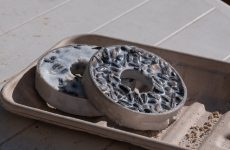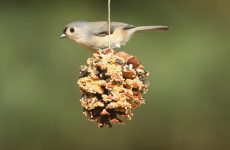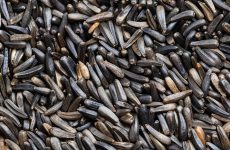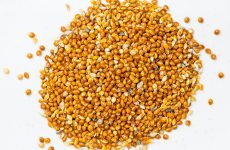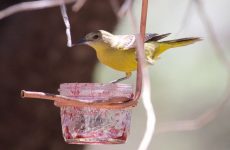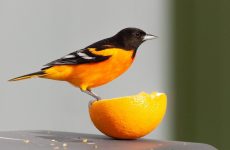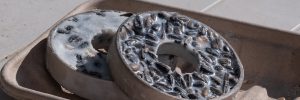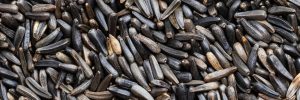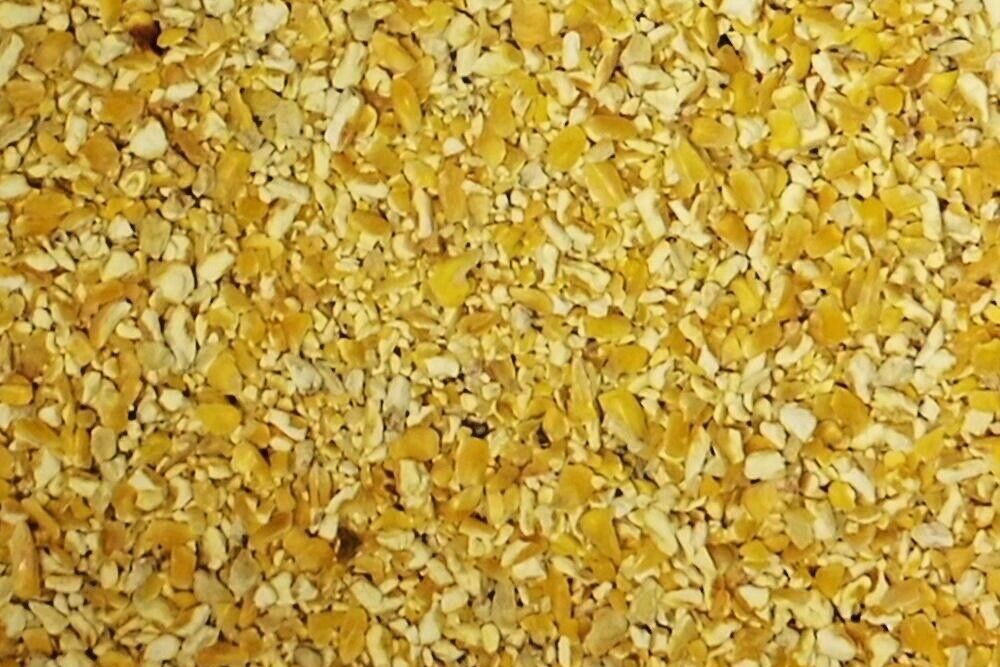
Cracked corn is dried corn broken into smaller pieces, making it easier for birds to eat, especially smaller birds. Cracked corn provides energy for birds but is not a complete nutrient-rich feed and can be mixed with other types of seed to give a more balanced diet.
Many birds eat cracked corn, and it is a great and cheap way to attract more birds to your backyard.
Cracked corn is eaten by many types of birds, such as:
- Cardinals
- Doves
- Jays
- Juncos
- Ducks
- Grouse
- Quail
- Crows
- Sparrows
- Blackbirds
- Grackles
- Pigeon
40 Types of Birds That Eat Cracked Corn:
1. Northern Cardinal
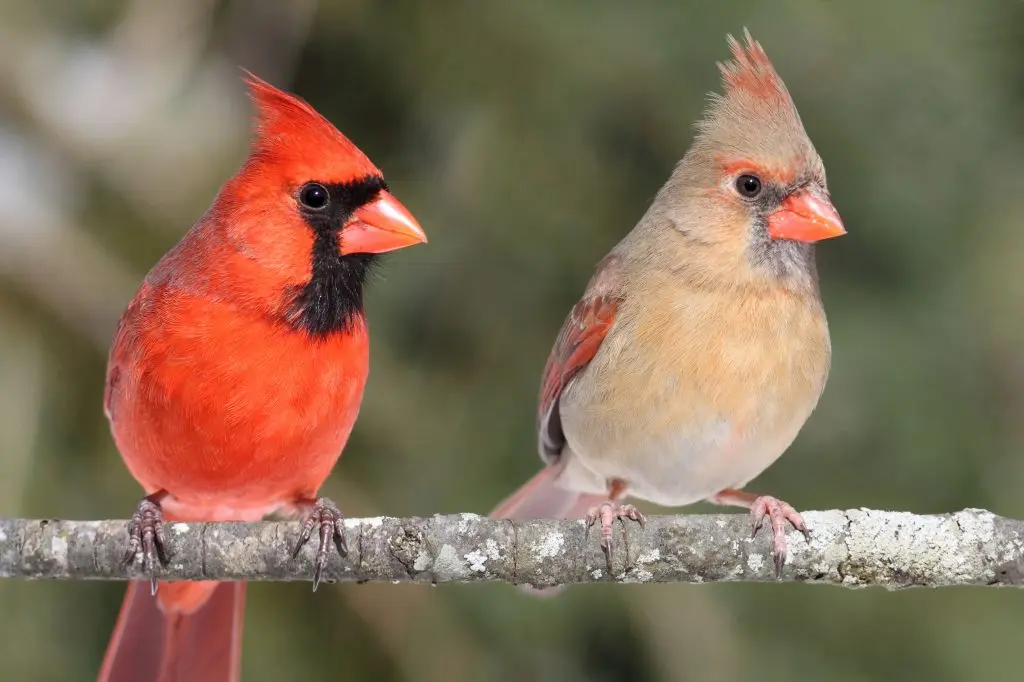
The bright red male Northern Cardinal with black around their faces is an incredible sight, especially against a white winter background. They also have red crests and beaks.
Females are also a little showy with their brown coloring, sharp brown crest, red highlights, and red beaks.
- Cardinalis cardinalis
- Length: 8.3-9.1 in (21-23 cm)
- Weight: 1.5-1.7 oz (42-48 g)
- Wingspan: 9.8-12.2 in (25-31 cm)
Northern Cardinals live in the Eastern half of the US and some states in the south as far west as Arizona.
You can find Northern Cardinals in dense vegetation foraging for seeds, fruit, and insects. Northern Cardinals will sometimes attack their own reflection during the breeding season as they obsessively defend their territories.
Northern Cardinal Song:
Northern Cardinal Call:
Attract Northern Cardinals to your backyard with feeders full of sunflower seeds, peanut hearts, millet, and milo. They will feed from large tube feeders, hoppers, platform feeders, or food scattered on the ground.
2. Mourning Dove
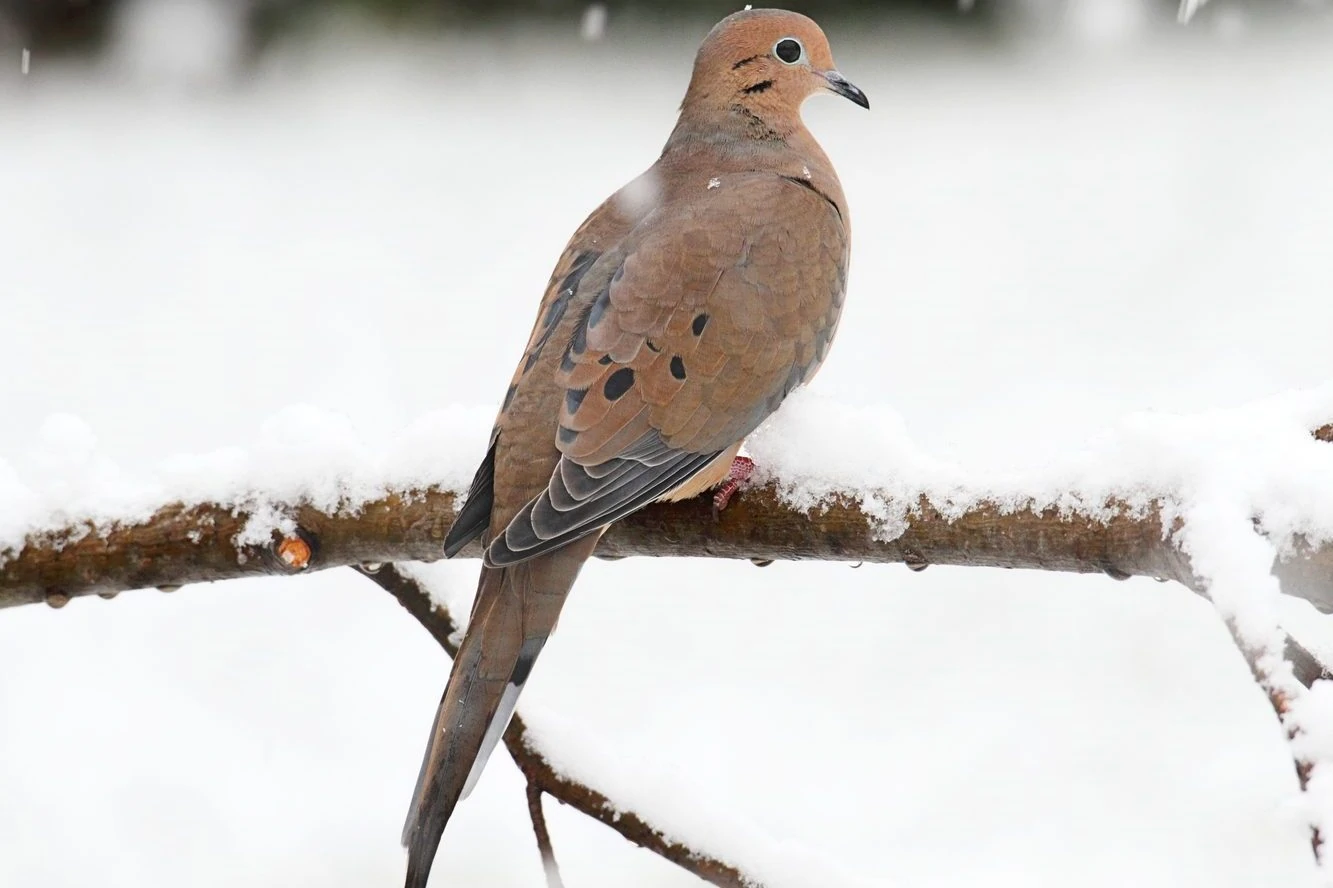
Mourning Doves are graceful small-headed birds with plump bodies and long tails. They are a soft brown color with black spots on the wings. Males are slightly heavier than females.
- Zenaida macroura
- Length: 9.1-13.4 in (23-34 cm)
- Weight: 3.0 -6.0 oz (96-170 g)
- Wingspan: 17.7 in (45 cm)
Mourning Doves are common over all of the lower 48 all year but may migrate after breeding from the north of the Midwest and southern Canada.
Mourning Doves can be seen perching on telephone wires and foraging for seeds on the ground in grasslands, fields, and backyards. They can also be found in open areas or woodland edges.
Mourning Dove call:
Attract Mourning Doves to your backyard by scattering millet on the ground or platform feeders. They will also eat black sunflower seeds, nyjer, cracked corn, and peanut hearts.
3. American Crow
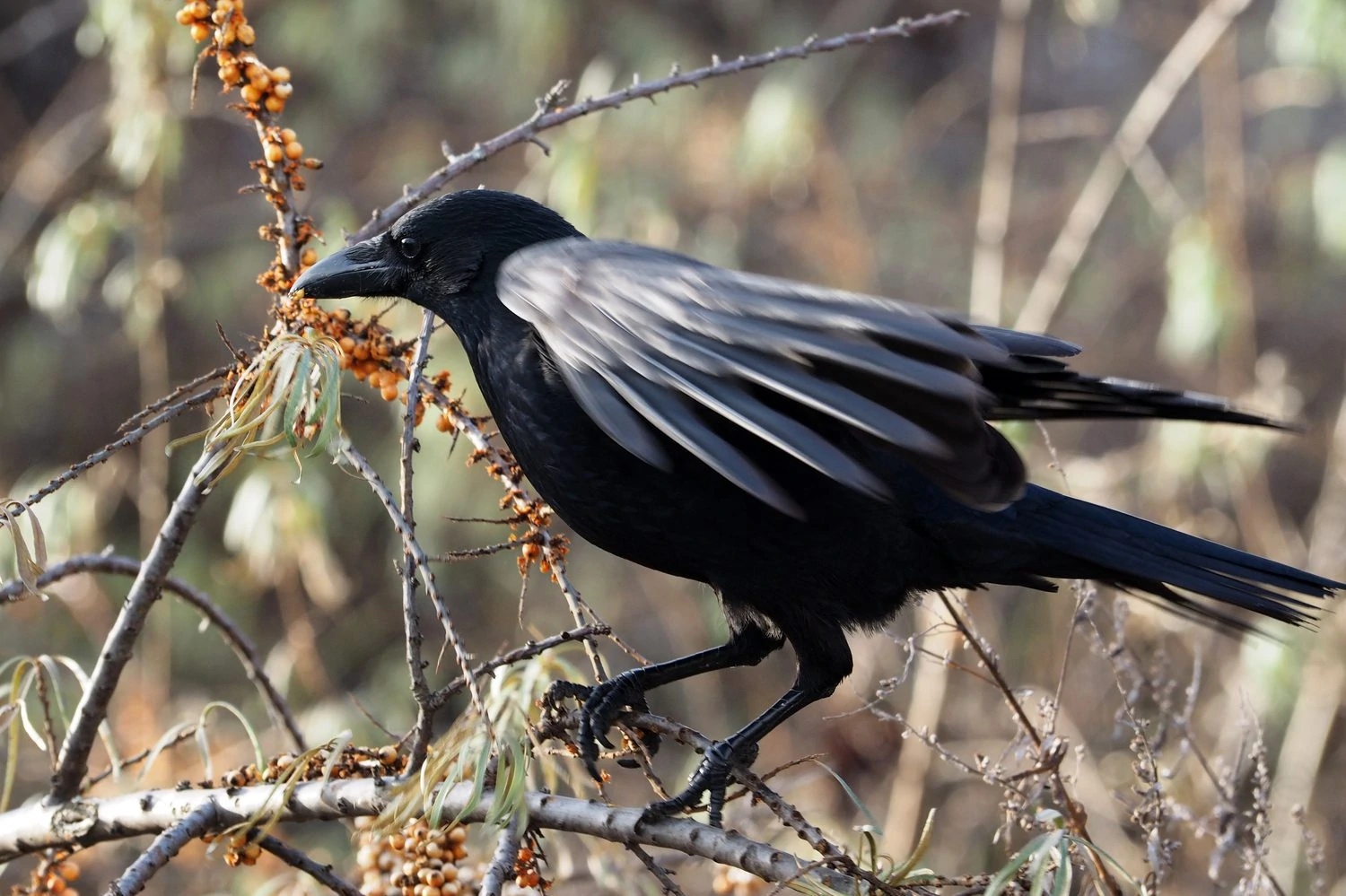
American crows are large all-black birds that make a hoarse, cawing sound.
- Corvus brachyrhynchos
- Length: 15.8-20.9 in (40-53 cm)
- Weight: 11.2-21.9 oz (316-620 g)
- Wingspan: 33.5-39.4 in (85-100 cm)
American Crows are residents all year in most of the lower 48 and the Pacific Coast in Canada and Alaska. Those that breed in Canada and the northern Midwest migrate south for winter.
They are common birds found in most habitats, including treetops, woods, fields, beaches, or towns.
They eat most things and usually feed on the ground, eating earthworms, insects, seeds, and fruit. They also eat fish, young turtles, mussels, and clams and will even eat eggs and nestlings of many species of birds.
In winter, American Crows gather in large numbers of up to two million crows to sleep in noisy communal roosts.
American Crow Call:
Attract American Crows to your backyard by scattering peanuts, but they can become a nuisance as they are attracted by garbage or pet food if left out.
4. Blue Jay
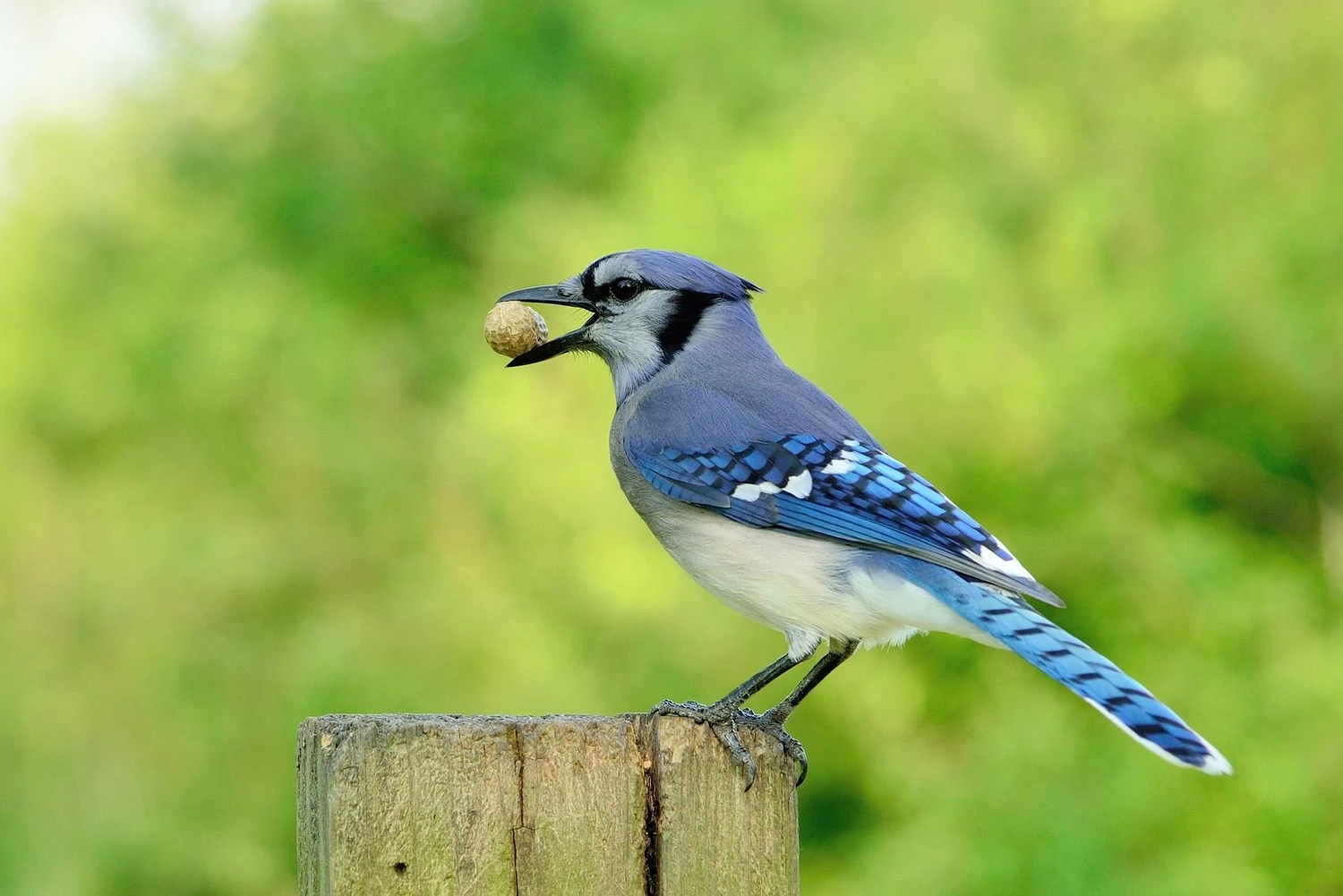
Blue Jays are common large songbirds with a blue upright crest, blue and black backs, and white undersides.
- Cyanocitta cristata
- Length: 9.8-11.8 in (25-30 cm)
- Weight: 2.5-3.5 oz (70-100 g)
- Wingspan: 13.4-16.9 in (34-43 cm)
Blue Jays live in eastern US states and Southern Canada all year. Some birds will migrate west for winter but not very frequently.
They are noisy birds that travel in family groups eating acorns when available. They can be found in forests, mainly near oak, as they eat acorns. They can also be found in backyards near feeders. As well as acorns, they eat insects, nuts and seeds, and grain. They may also take eggs from nests or take nestlings.
Blue Jay Call:
Blue Jays are large birds and prefer to fly in, grab a peanut or sunflower seed and take it away to feed. They prefer platform or tray feeders to make it easy to make a quick exit.
Attract Blue Jays to your backyard with peanuts, sunflower seeds, and suet. They prefer these on open tray feeders or hopper feeders on a post. They will also enjoy a birdbath.
5. Song Sparrow
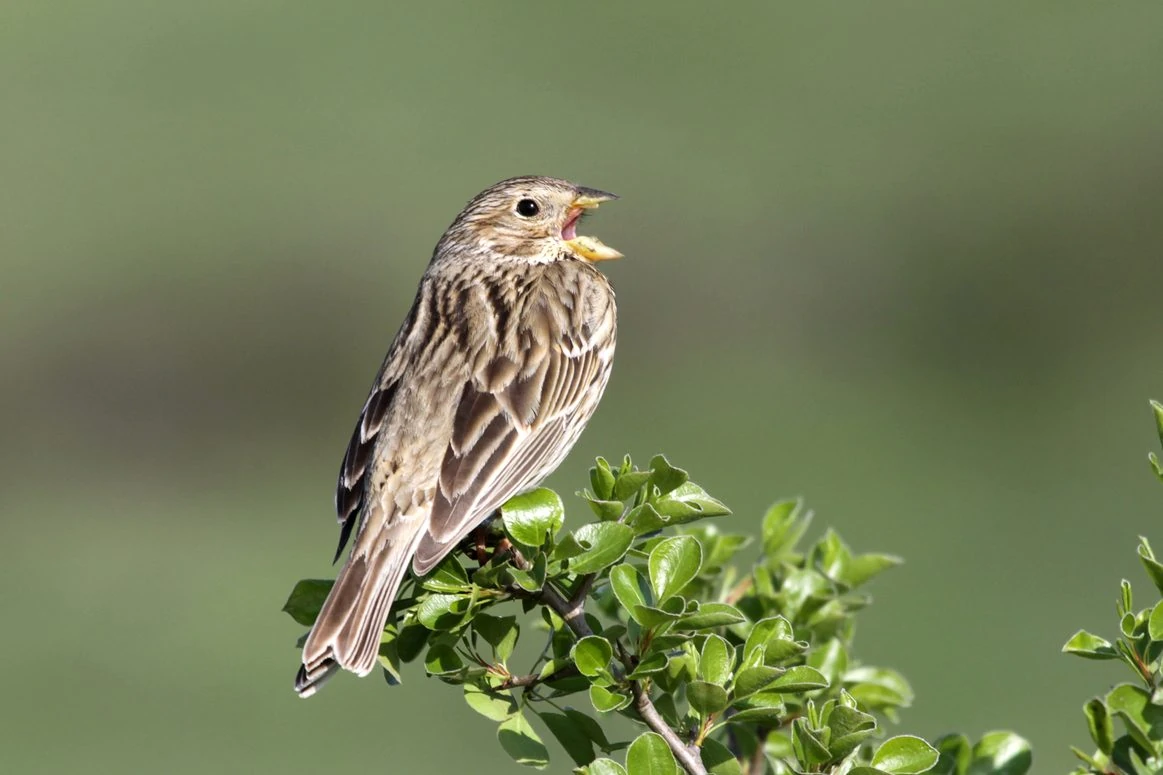
Song sparrows are not as remarkable looking as other backyard birds, but these predominantly brown-streaked birds use their almost constant song to attract mates in spring and summer.
- Melospiza melodia
- Length: 4.7-6.7 in (12-17 cm)
- Weight: 0.4-1.9 oz (12-53 g)
- Wingspan: 7.1-9.4 in (18-24 cm)
Song Sparrow live all year in the northern US states. Those that breed in Canada migrate to southern US states for winter.
They can be found in open, shrubby, and wet areas, often perched on a low shrub singing. They are often found at backyard feeders.
Song Sparrows eat a wide variety of insects and plants, including beetles, caterpillars, midges, spiders, and earthworms. They will also eat buckwheat, sunflower, raspberries, wild cherries, blackberries, wheat, and rice.
Song Sparrow Song:
Song Sparrow Call:
Attract Song Sparrows to your backyard feeders by putting black oil sunflower seeds, cracked corn, and nyjer on platform feeders.
6. Red-winged Blackbird
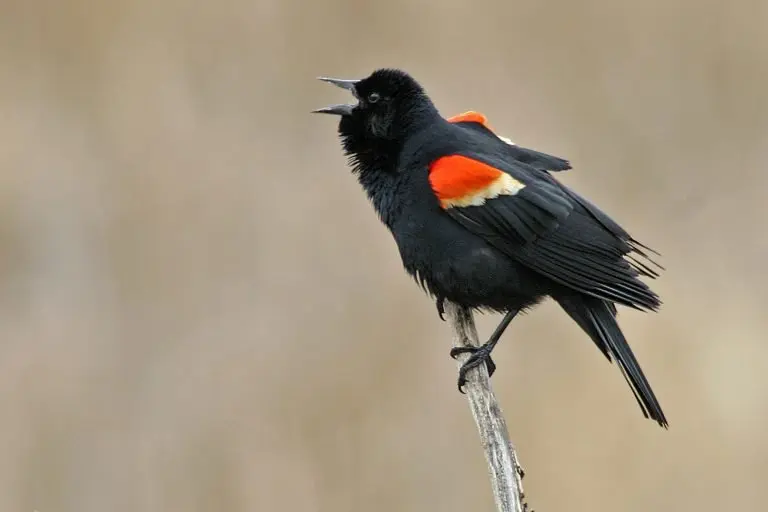
Red-winged blackbirds are very common and easy to identify with the all-black coloring except for the reddish-orange wing patches. Females are rather dull in comparison with streaky brown color.
- Agelaius phoeniceus
- Length: 6.7-9.1 in (17-23 cm)
- Weight: 1.1-2.7 oz (32-77 g)
- Wingspan: 12.2-15.8 in (31-40 cm)
Red-winged Blackbirds remain all year in the lower 48 and the Pacific Coast of British Columbia. Those that breed in Canada and some northern US states migrate south for the winter.
They can often be spotted sitting on telephone wires, and the males will fiercely defend their territories in the breeding season, even attacking people that get too close to nests. In winter, they roost in large numbers into the millions.
Red-winged Blackbird Song:
Red-winged Blackbird Calls:
Attract Red-winged blackbirds to your backyard with mixed grain and seeds spread on the ground. They will also feed from large tube feeders or platform feeders.
7. European Starling
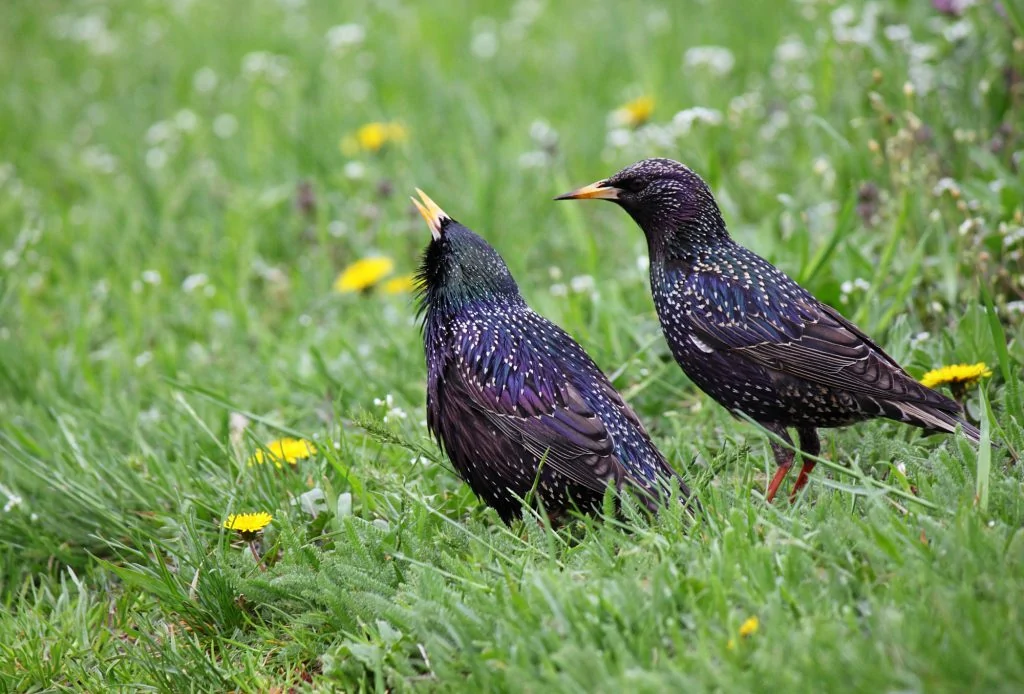
European Starlings are not native but are now one of the most numerous songbirds. They are stocky black birds with iridescent purple, green, and blue tones.
- Sturnus vulgaris
- Length: 7.9-9.1 in (20-23 cm)
- Weight: 2.1-3.4 oz (60-96 g)
- Wingspan: 12.2-15.8 in (31-40 cm)
European Starlings live in all North America, except the north of Canada and Alaska.
They are considered a pest by some due to their aggressive behavior. These birds fly in large, noisy flocks and can be seen perched in groups on the top of trees or flying over fields.
European Starling Calls:
Starlings predominantly eat insects, including beetles, flies and caterpillars, earthworms, and spiders. However, they also eat fruit, including cherries, holly berries, mulberries, Virginia Creeper, sumac, blackberries, and grains and seeds.
Attract European Starlings to your backyard feeders with black oil sunflower seeds, suet, cracked corn, and peanuts.
8. Red-bellied Woodpecker
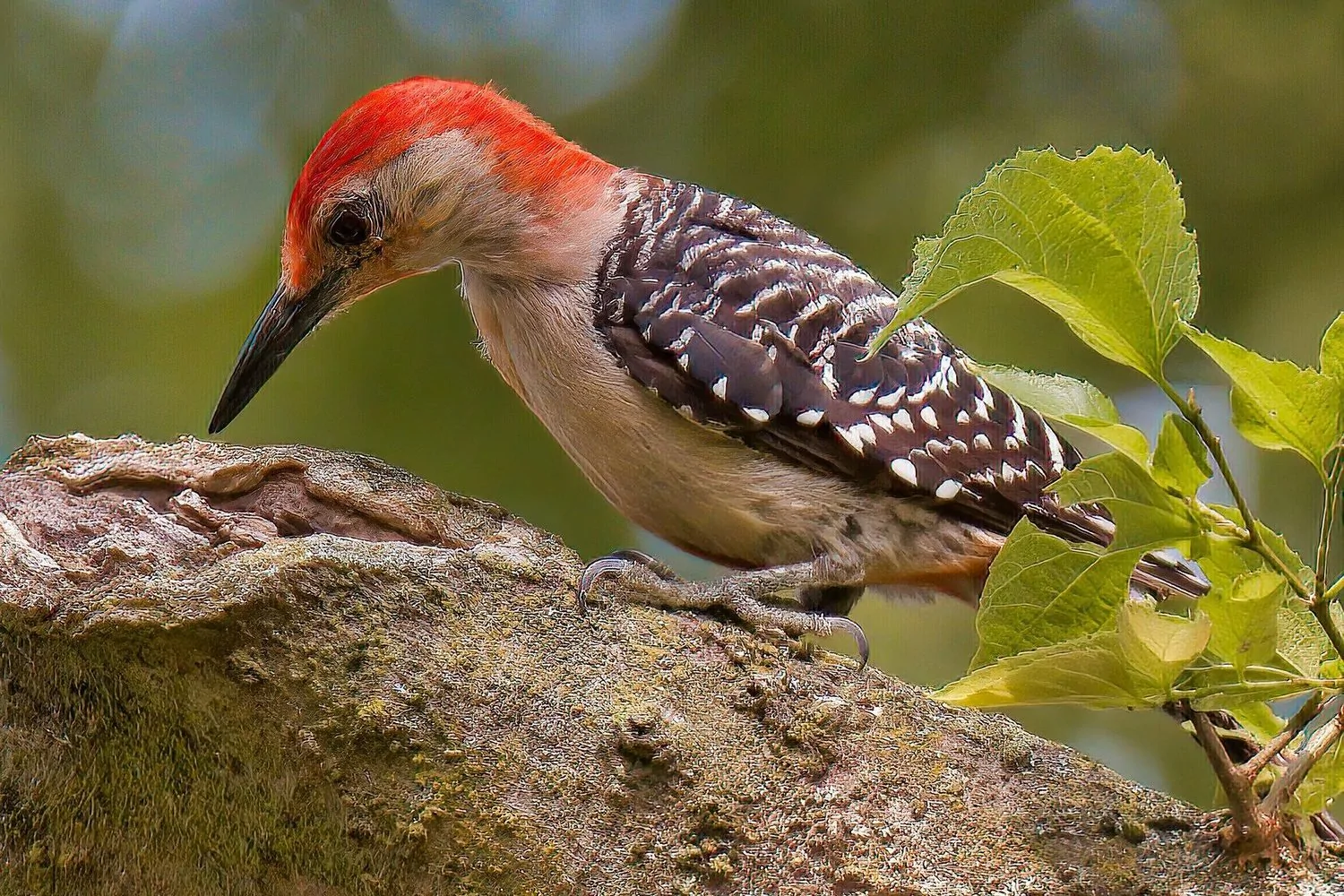
Red-bellied Woodpeckers can be mistaken for Red-headed Woodpeckers as they have red caps, but they are much smaller than the Red-headed Woodpecker. Female Red-bellied Woodpeckers lack the red cap and only have red at the back of their heads.
They also have a very pale red belly that can be hard to spot, but they do have the typical woodpecker black and white markings over their backs.
- Melanerpes carolinus
- Length: 9.4 in (24 cm)
- Weight: 2.0-3.2 oz (56-91 g)
- Wingspan: 13.0-16.5 in (33-42 cm)
Red-bellied Woodpeckers can be found in eastern US states, and they do not migrate.
Red-bellied Woodpeckers eat insects, spiders, seeds from grasses, fruit, and nuts. They will also sometimes eat nestlings. They nest in dead trees and may use the same nest year after year. They lay 4-5 white eggs on a bed of wood chips.
The tongue of the Red-bellied Woodpecker sticks out 2 inches past the beak and is barbed at the tip, along with sticky spit. This helps catch prey from deep crevices.
Red-bellied Woodpecker Call:
Red-bellied Woodpeckers can often be seen at bird feeders, especially if you live near wooded areas. They make a distinctive loud rolling call which means you will often hear them before you see them.
9. House Sparrow
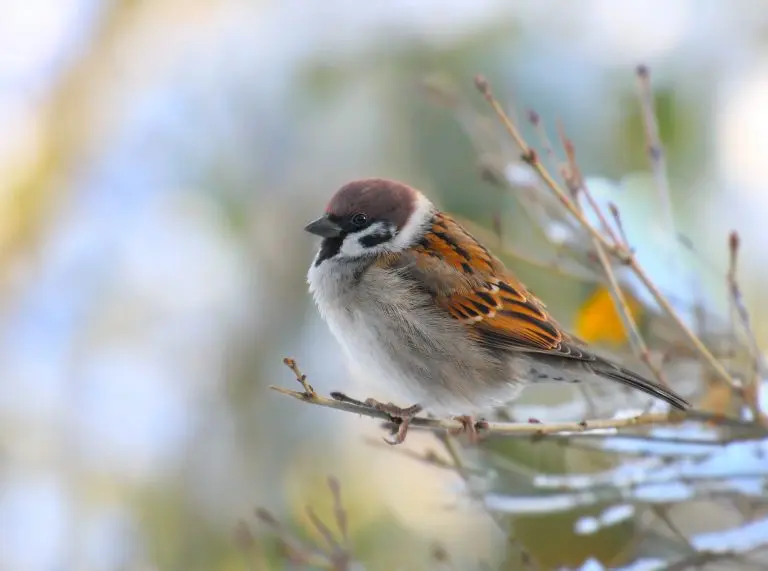
The House Sparrow is another introduced species that has done very well and is now one of the most common birds. They have gray and brown heads and white cheeks. Their backs are black and brown, and their bellies are gray.
- Passer domesticus
- Length: 5.9-6.7 in (15-17 cm)
- Weight: 0.9-1.1 oz (27-30 g)
- Wingspan: 7.5-9.8 in (19-25 cm)
House Sparrows live in the US and Southern Canada all year.
You can find them near houses and buildings, and they can be pretty tame, and they may even eat out of your hand.
House Sparrows eat mostly grain and seed as well as discarded food. They can be considered a pest because they are non-native, but they are found in backyards even if you do not feed them.
House Sparrow Song:
Attract House Sparrows to your backyard feeders with most kinds of birdseed, including millet, corn, and sunflower seeds.
10. Dark-eyed Junco
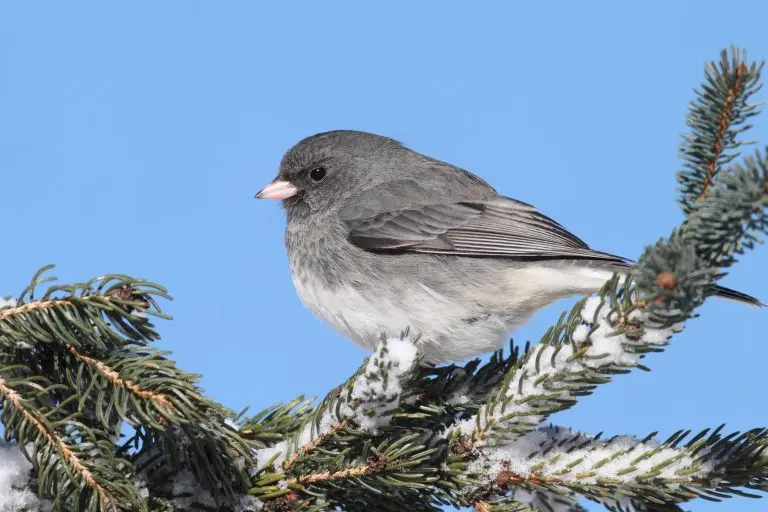
Dark-eyed Juncos are sparrows that are different colors depending on the state. They are generally slate-colored in the east and black, white, and brown in the west.
- Junco hyemalis
- Length: 5.5-6.3 in (14-16 cm)
- Weight: 0.6-1.1 oz (18-30 g)
- Wingspan: 7.1-9.8 in (18-25 cm)
Dark-eyed Juncos remain resident all year in northeastern and western US states and the Appalachian Mountains. Those that breed in Canada and Alaska migrate south in winter to the United States.
They can be found in open and partially wooded areas, often on the ground, and are common across the continent.
Dark-eyed Junco Song:
Attract Dark-eyed Juncos to backyard feeders with a variety of seeds such as black oil sunflower seeds, nyjer, cracked corn, millet, and peanuts. Platform feeders or scattered on the ground is best.
11. Northern Flicker
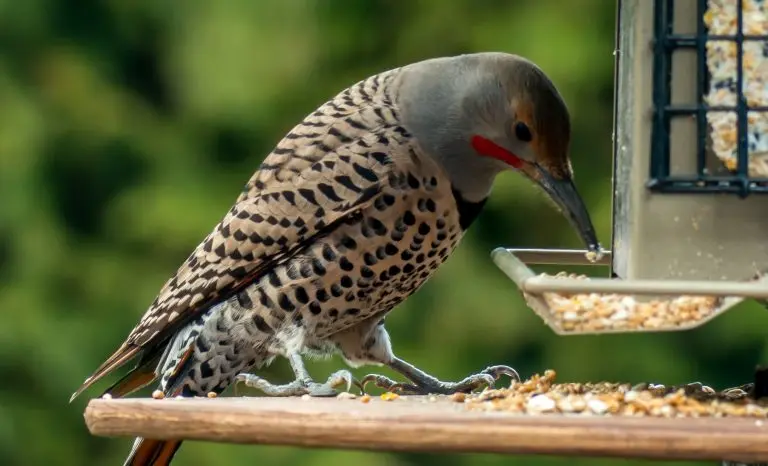
Northern Flickers are large brown woodpeckers with black spots and a white patch on their rump in flight, plus a red nape of the neck in the males.
Northern Flickers have red or yellow flashes in the wings and tail depending on where they originate. Red-shafted birds live in the west, and yellow-shafted birds live in the east.
- Colaptes auratus
- Length: 11.0-12.2 in (28-31 cm)
- Weight: 3.9-5.6 oz (110-160 g)
- Wingspan: 16.5-20.1 in (42-51 cm)
Northern Flickers can be spotted across the US all year and in Canada during summer. Those that breed in Canada migrate south for the winter.
Northern Flickers mainly eat ants, beetles, fruits, and seeds, and they can often be seen on the ground digging with their curved bill.
Northern flicker Call:
Attract Northern Flickers to your backyard with suet.
12. Common Grackle
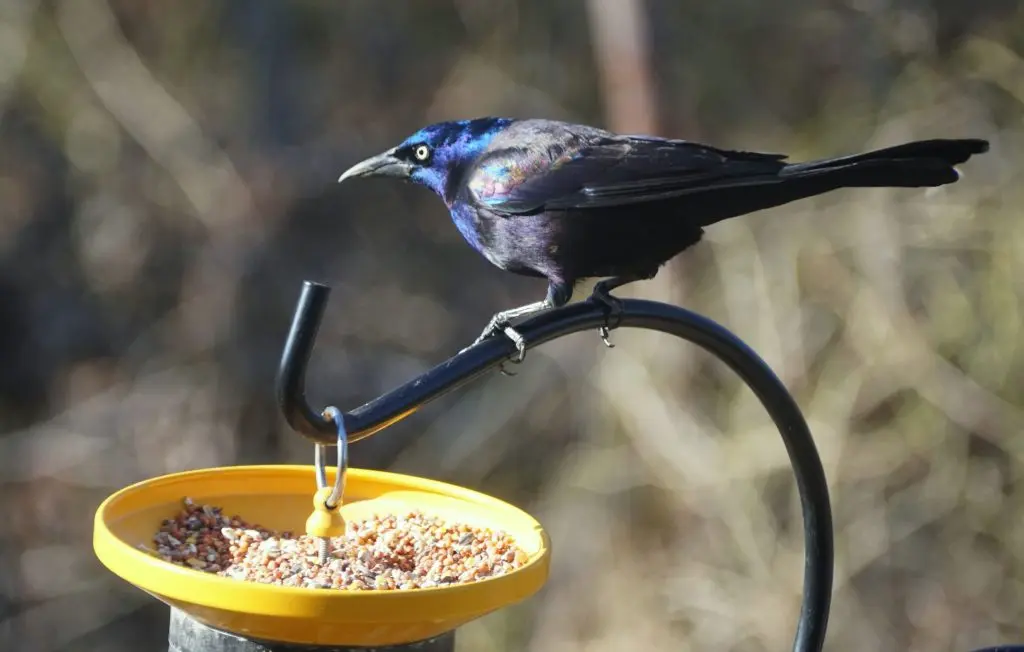
The Common Grackle is a blackbird taller and longer tailed than a typical blackbird with glossy iridescent bodies.
- Quiscalus quiscula
- Length: 11.0-13.4 in (28-34 cm)
- Weight: 2.6-5.0 oz (74-142 g)
- Wingspan: 14.2-18.1 in (36-46 cm)
Common Grackles are resident all year in southeastern states, but those that breed in Canada and the Midwest migrate south.
They eat many crops but mostly corn, and they gather in noisy groups high up in trees. Unfortunately, they will also eat garbage and so can be a nuisance. Their habitat is varied and includes open woodlands, marshes, parks, and fields.
They may gather in their millions in winter to forage and roost, mixed in with other species of blackbirds.
Common Grackle Call:
Attract more Common Grackles to your backyard with mixed grain and seed sprinkled on the ground or platform feeders.
13. White-throated Sparrow
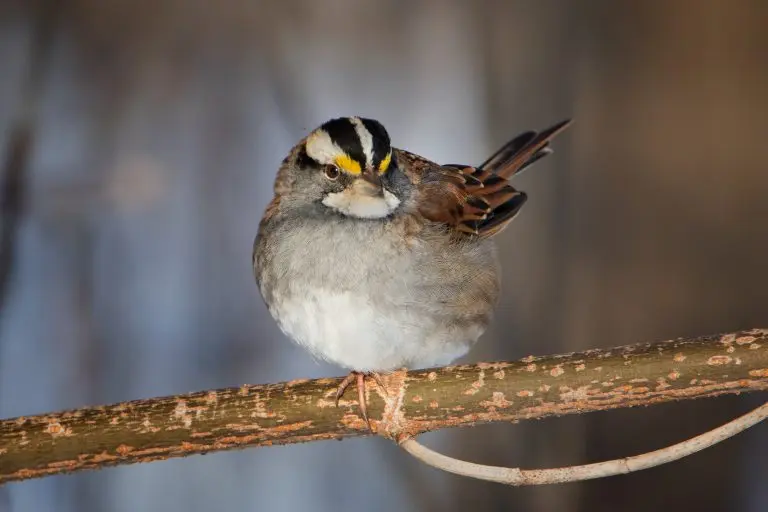
White-throated Sparrows have a distinctive black and white striped head, bright white throat, and yellow between the eye and bill. Their backs are brown, and underneath is gray.
- Zonotrichia albicollis
- Length: 6.3-7.1 in (16-18 cm)
- Weight: 0.8-1.1 oz (22-32 g)
- Wingspan: 7.9-9.1 in (20-23 cm)
White-throated Sparrows are migratory birds, breeding mainly in Canada before heading south in winter to eastern and southern US states and the Pacific Coast.
You can find White-throated Sparrows on the ground in forests and woods and along the edges of wooded areas, often in large flocks.
White-throated Sparrows diet is mainly seeds of grasses and weeds and fruits such as grape, sumac, mountain ash, blueberry, blackberry, and dogwood. They will also eat many insects from the forest floor, especially in summer.
White-throated Sparrow Song:
Attract White-throated Sparrows to your backyard with millet and black oil sunflower seeds on platform feeders.
14. Brown-headed Cowbird
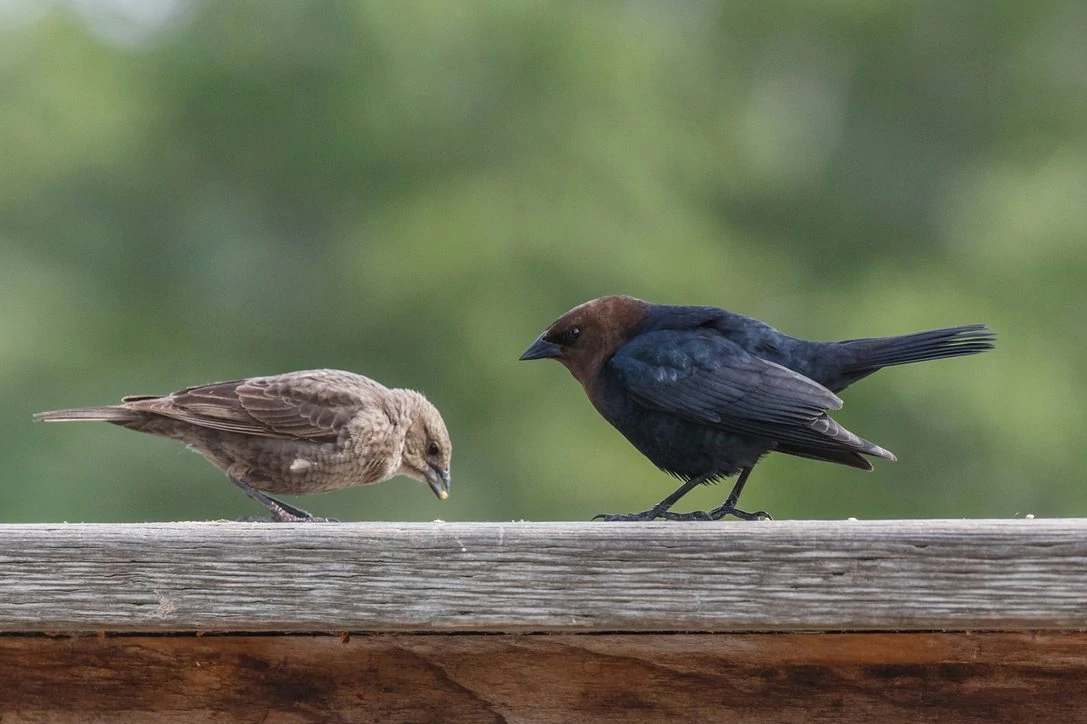
Males Brown-headed Cowbirds are larger than females, with black-bodies, brown heads, and short tails. Female Brown-headed Cowbirds are brown all over with slight streaking.
- Molothrus ater
- Length: 76.3-8.7 in (19-22 cm)
- Weight: 1.3-1.8 oz (42-50 g)
- Wingspan: 14.2 in (36 cm)
Brown-headed Cowbirds remain all year in eastern US states, southern US states, and along the Pacific Coast. However, those that breed in northern and western US states and Canada migrate south for winter.
Brown-headed Cowbird Song:
They are often considered a nuisance because they are parasite birds that destroy the eggs of smaller songbirds so they can lay their eggs in the nest and have the bird foster their chicks.
15. Rock Pigeon
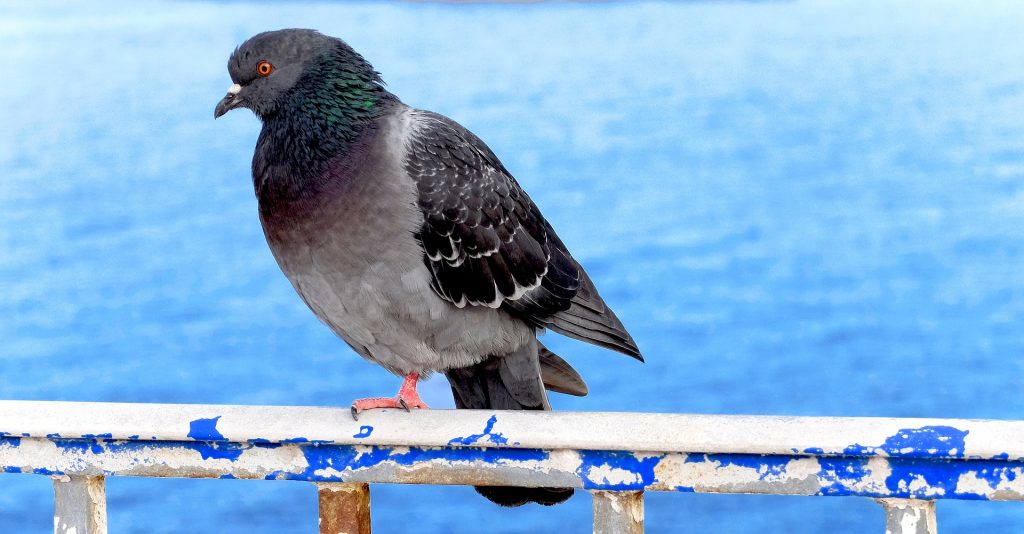
Rock Pigeons are blueish gray with two black bands on the wing and black on the tail tip. They have iridescent throat feathers and orange eyes.
- Columba livia
- Length: 11.8-14.2 in (30-36 cm)
- Weight: 9.3-13.4 oz (265-380 g)
- Wingspan: 19.7-26.4 in (50-67 cm)
Rock Pigeons do not migrate and can be found in all US states, southern Canada, and the Pacific Coast to Alaska.
They are common in cities and visit backyards, especially for birdseed on the ground. Some cities have ordinances against feeding pigeons as they are considered pests.
16. Common Raven
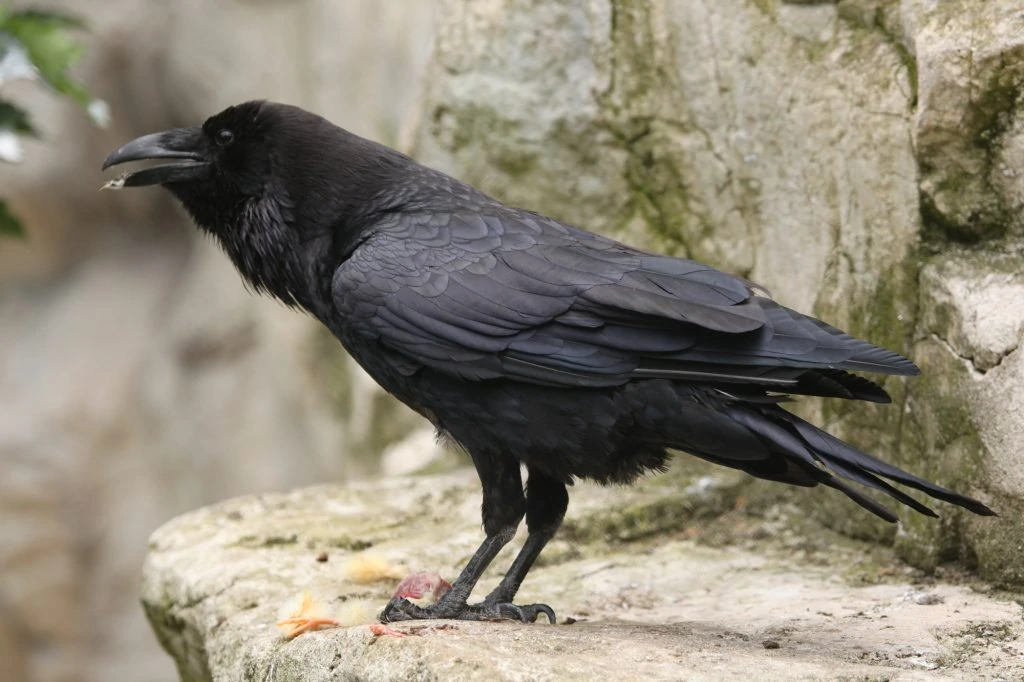
Common Ravens are thought to be one of the smartest and definitely one of the largest species in the songbird family. They have shaggy throat feathers, large black beaks, and wedge-shaped tails.
- Corvus corax
- Length: 22.1-27.2 in (56-69 cm)
- Weight: 24.3-57.3 oz (689-1625 g)
- Wingspan: 45.7-46.5 in (116-118 cm)
Common Ravens are resident in Canada, western US states, northeastern US states, Mexico, and northern Central America. They are not found in the Great Plains or eastern US states.
You can find Common Ravens in most places, and they especially follow humans. Forests, beaches, fields, grasslands are all places to find them and rural human areas. They are not common in towns and cities as American Crows take over.
Not known as picky eaters, Common Ravens will eat most things, including any small animals, eggs and nestlings, plus insects and fish. Human rubbish and pet food
Common Raven sounds: Mostly croaks and harsh calls
Nests of Common Ravens are usually relatively high up on cliffs, trees, bridges, and towers. Their nests are made from long sticks and are large, up to 5 feet across and 2 feet high. The inside of the nest will be lined with mud and softer material, such as grass and wool.
Common Ravens lay up to seven eggs, and they take around three weeks to hatch and about five weeks to fledge.
Fun Fact: Common Ravens in Canada weigh up to 60% more than those in California.
17. White-crowned Sparrow
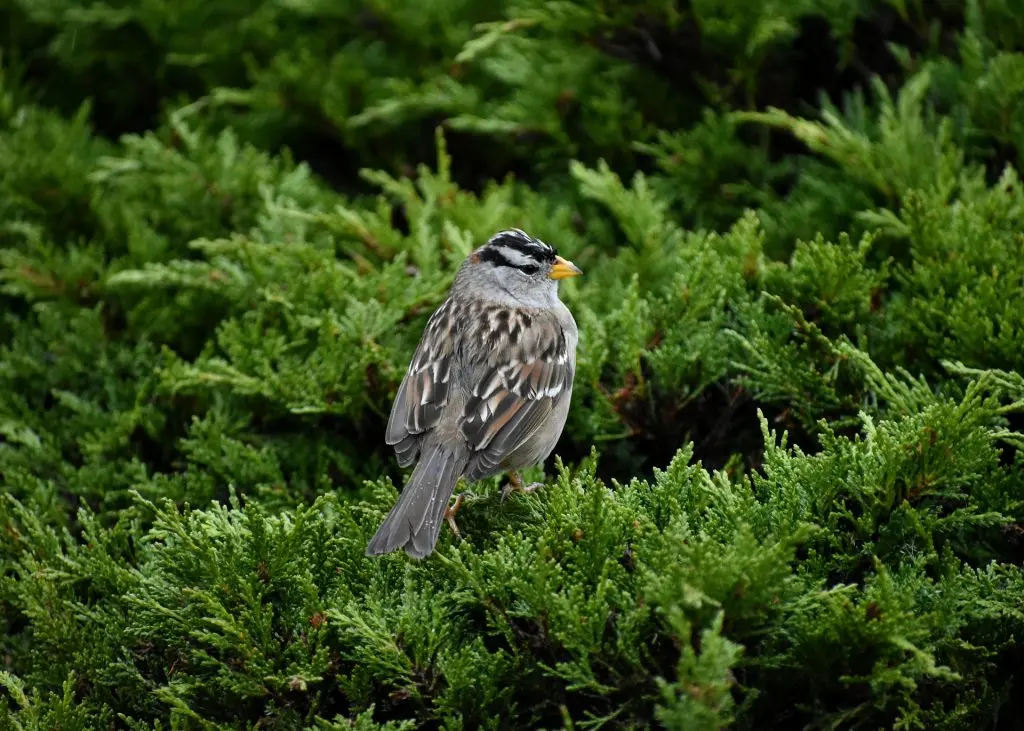
White-crowned Sparrows are large grayish sparrows with long tails, small bills, and bold black and white stripes on their heads.
- Zonotrichia leucophrys
- Length: 5.9-6.3 in (15-16 cm)
- Weight: 0.9-1.0 oz (25-28 g)
- Wingspan: 8.3-9.4 in (21-24 cm)
White-crowned Sparrows breed in Alaska and arctic Canada before heading south to the lower 48 and Mexico for winter. However, some may remain along the Pacific Coast and the mountainous west all year.
You can find White-crowned Sparrows in weedy fields, along roadsides, forest edges, and in yards foraging for seeds of weeds and grasses or fruit such as elderberries and blackberries.
White-crowned Sparrow Song:
Attract White-crowned Sparrows to your backyard with sunflower seeds, and they will also eat seeds that other birds drop at feeders.
18. Eastern Towhee
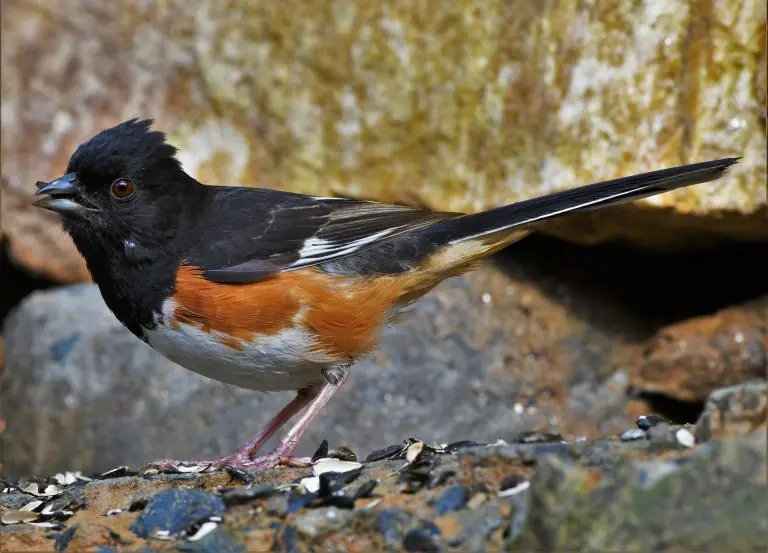
Eastern Towhees are striking large sparrows, about the size of Robin, with a black head, throat, and back, reddish sides, long tails, and a white belly in the males. The females are similar but brown instead of black.
- Pipilo erythrophthalmus
- Length: 6.8-8.2 in (17.3-20.8 cm)
- Weight: 1.1-1.8 oz (32-52 g)
- Wingspan: 7.9-11.0 in (20-28 cm)
Eastern Towhees live all year in southeastern US states, but birds further north move south for the winter.
You can find Eastern Towhees rummaging in the undergrowth along the edges of forests and thickets.
Eastern Towhee Song:
Attract Eastern Towhees to your backyard with overgrown borders, and they will also visit platform feeders for black oil sunflower seeds, hulled sunflower seeds, cracked corn, and millet.
19. Eurasian Collard Dove
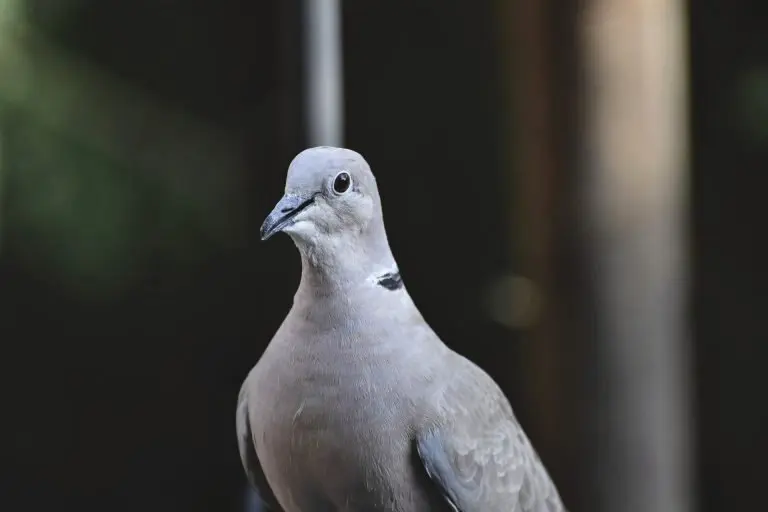
Eurasian-collard Doves are light brownish-gray, with white patches in the tail, and look very similar to Mourning Doves, but with a black half collar at the nape of the neck, they are also larger, and with a square tail rather than pointed.
- Length: 11.4-11.8 in (29-30 cm)
- Weight: 4.9-6.3 oz (140-180 g)
- Wingspan: 13.8 in (35 cm)
Eurasian Collared-Doves are an introduced species that only arrived in the 1980s but now live across most of the country.
Eurasian Collared-Doves eat a wide variety of seeds and grain but also will eat some berries and insects.
20. Spotted Towhee
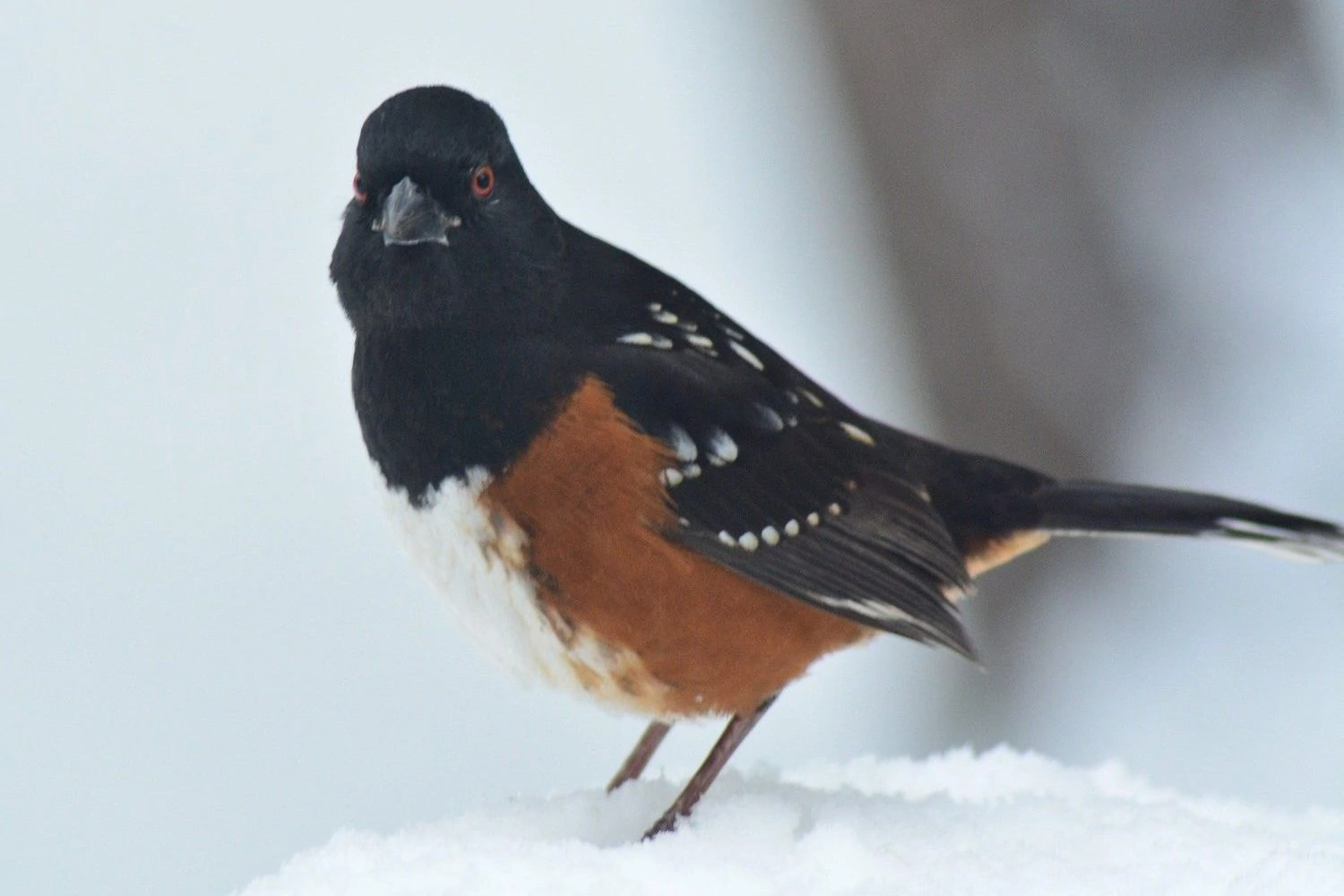
Spotted Towhees are large sparrows that are black on their head, throat, and back in the males and brown in the females. Both males and females have reddish-brown sides, white bellies, and white spots on the wings and back. They have long tails and are about the size of a Robin.
- Pipilo maculatus
- Length: 6.7-8.3 in (17-21 cm)
- Weight: 1.2-1.7 oz (33-49 g)
- Wingspan: 11.0 in (28 cm)
Spotted Towhees live in western US states, but those in the interior of the north migrate south after breeding to Texas and surrounding areas.
You can find Spotted Towhees on the ground in dense tangles of shrubs scratching around for insects, including beetles, crickets, grasshoppers, caterpillars, wasps, and bees. They also eat acorns, berries, and seeds.
Spotted Towhee Song:
Attract Spotted Towhees to your yard if you leave overgrown borders, and they will visit platform feeders or ground feeders for black oil sunflower seeds, hulled sunflower seeds, cracked corn, millet, and milo.
21. Brown Thrasher
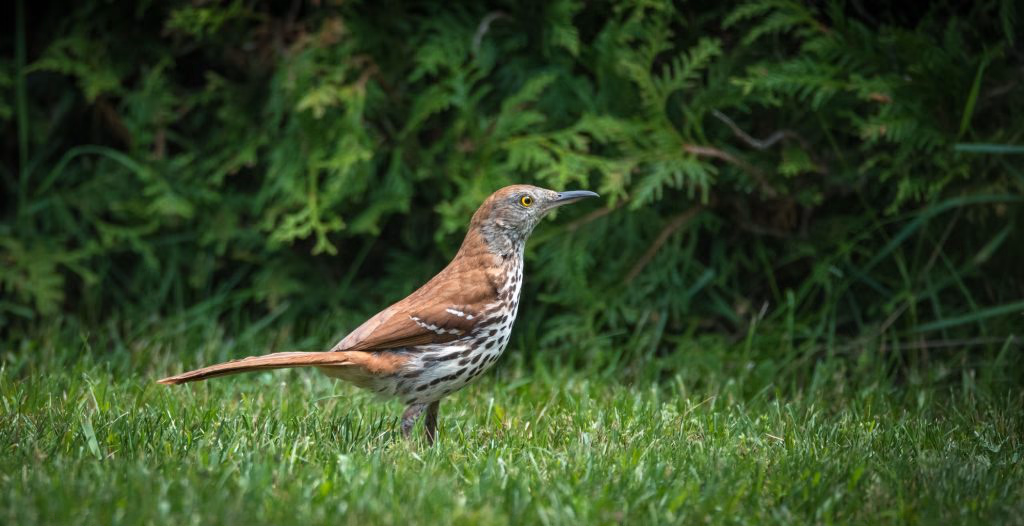
Brown Thrashers are large songbirds with long proportions. They are about the same size as a robin. They are brown on the back and with white-streaked chests and bellies. Their faces are gray with bright yellow eyes.
- Length: 9.1-11.8 in (23-30 cm)
- Weight: 2.1-3.1 oz (61-89 g)
- Wingspan: 11.4-12.6 in (29-32 cm)
Brown Thrashers live in central and eastern North America. Those birds in the southeast of their range remain all year, but birds further north migrate south for the winter.
Brown Thrashers are hard to spot for their size as they spend most of their time in thickets and shrubbery. However, they can be heard rummaging along the ground in the leaf litter and soil, looking for insects.
Brown Thrashers also eat berries, beetles, and flying insects from the air. They may come to your backyard if there is dense cover and berry shrubs and they collect fallen seed from under feeders.
Over 1000 different song types are sung by these most accomplished songbirds, which is one of the largest of any North American songbird.
22. California Scrub-Jay
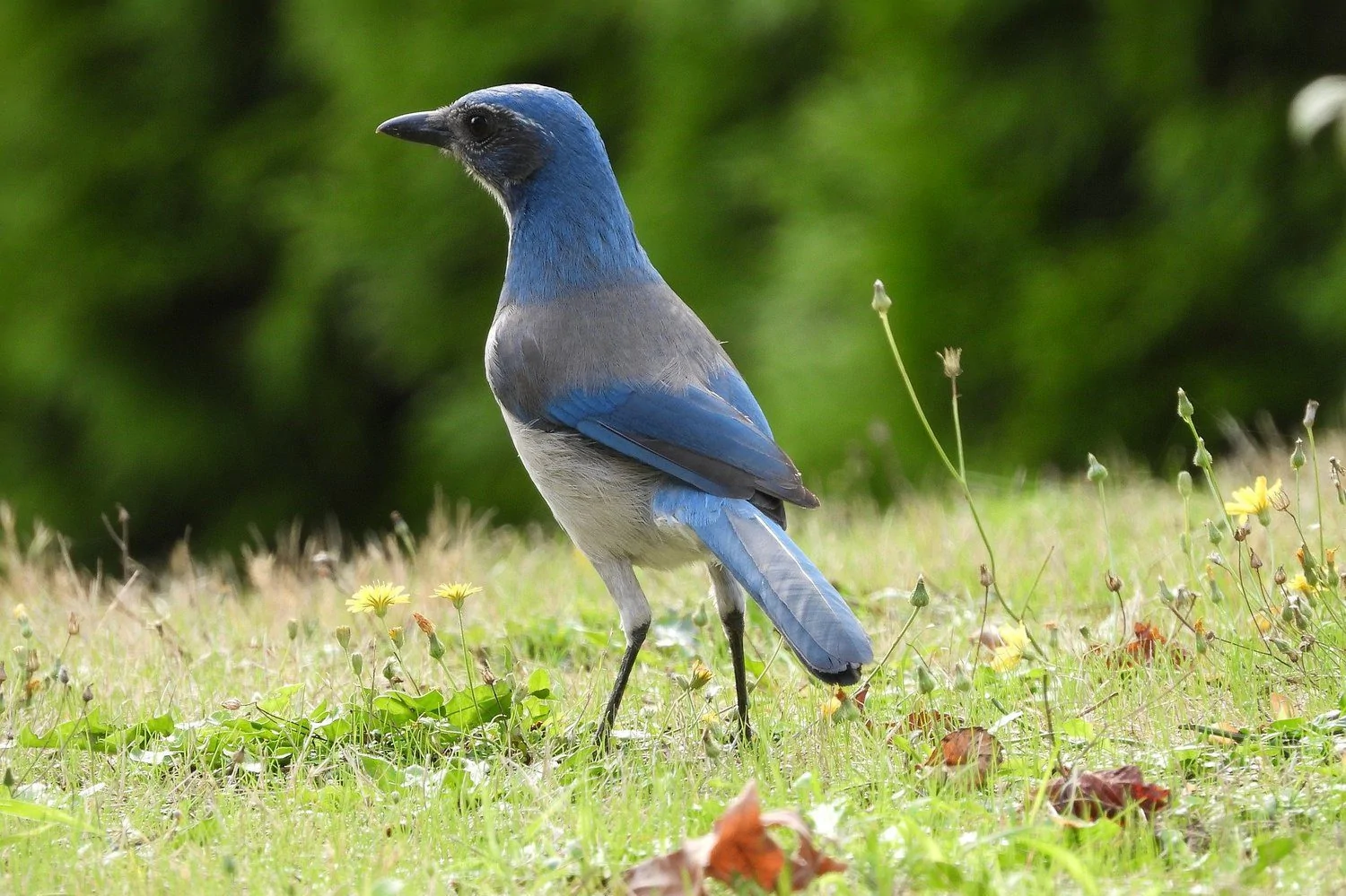
California Scrub-Jays are large songbirds with long tails, whitish undersides and rich blue and gray backs, and a bright blue breast band. They are larger than a robin but smaller than a crow. They look visually similar to the Woodhouse’s Scrub-Jay but with more vivid colors.
- Aphelocoma californica
- Length: 11.0-11.8 in (28-30 cm)
- Weight: 2.5-3.5 oz (70-100 g)
- Wingspan: 15.3 in (39 cm)
California Scrub-Jays are resident all year on the Pacific Coast from British Columbia down to Baja California.
You can find California Scrub-Jay in scrub, oak woodlands, and in suburban yards and parks. They eat insects and fruit during spring and summer and then seeds and nuts, especially acorns, in fall and winter.
California Scrub-Jay sounds: Their call is high-pitched and repetitive. They also sing a courtship song of soft whistles.
Nests of California Scrub-Jay are usually hidden in oak trees and can take up to 10 days to construct the nest made of twigs and a soft lining. They lay 1 – 5 eggs, and the eggs take around 17 – 19 days to hatch.
Attract California Scrub-Jays to your backyard with sunflower seeds and peanuts in your feeders.
Fun fact: California Scrub-Jay will screech over the body of a dead jay and invite others to do the same, and this can last up to half an hour, according to the University of California – Davis
23. Steller’s Jay
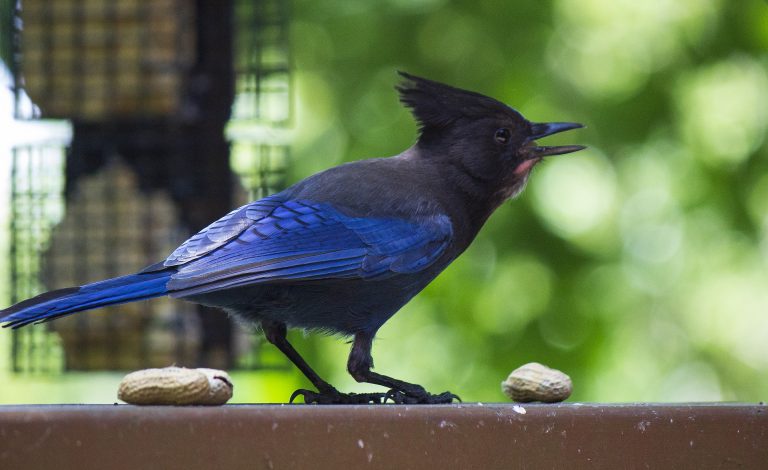
Steller’s Jays are large songbirds with black triangular crests that stick up from their heads. The rest of their heads and onto their chests and back are black, with the rest of their bodies being blue.
- Cyanocitta stelleri
- Length: 11.8-13.4 in (30-34 cm)
- Weight: 3.5-4.9 oz (100-140 g)
- Wingspan: 17.3 in (44 cm)
Steller’s Jays are resident in western US states, western Canada, Mexico, and Central America.
You can find Steller’s Jays in evergreen forests in the mountains, and they will also be found around picnic tables, campgrounds, and backyard feeders.
Steller’s Jays eat most things they can forage for, including insects, seeds, nuts, berries, eggs, and nestlings, but also making a nuisance of themselves around garbage and your unguarded picnic!
Steller’s Jay sounds: They make ‘kaw’ sounds as well as fast two-toned calls, peeps, and harsh guttural sounds. Steller’s Jays can also mimic other noises such as other bird species and even sprinklers and alarms.
Nests of Stellar’s Jays are usually near the top of conifer trees and are built from leaves and plant material held together with mud and lined with soft pine needles.
Attract Steller’s Jays to your backyard with peanuts and suet.
Fun fact: Stellar’s Jays make nests out of the mud.
24. Black-billed Magpie
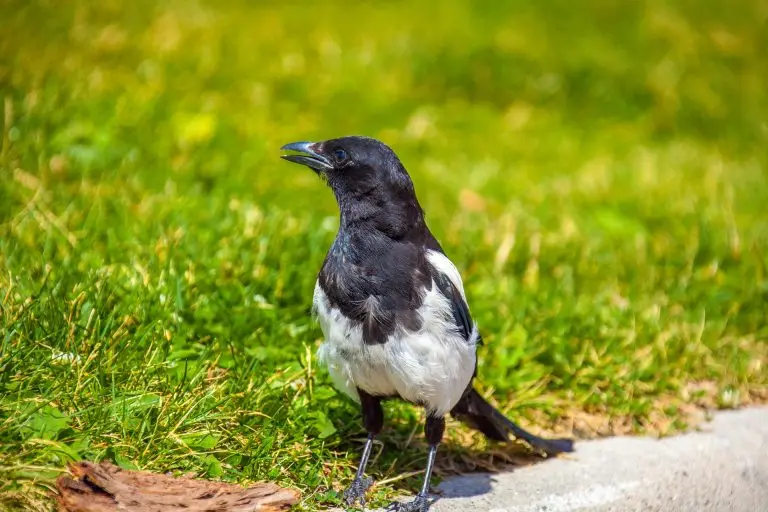
Black-billed Magpies, usually just called Magpies, are black and white birds that are noisy. They have long tails and blue-green iridescent flashes in the wing and tail. Males are up to 25% heavier than females.
- Pica hudsonia
- Length: 17.7-23.6 in (45-60 cm)
- Weight: 5.1-7.4 oz (145-210 g)
- Wingspan: 22.1-24.0 in (56-61 cm)
Black-billed Magpies live in northwestern US states and western Canada, and the coast of Alaska. They do not migrate.
You can find them walking on the ground in meadow and grasslands or other open areas feeding on fruit and grain, beetles, and grasshoppers. They have also been known to kill small mammals such as squirrels and voles and raid bird nests for eggs or nestlings and even carrion.
Black-billed Magpie sounds: A series of harsh calls and also a scream.
Nests of Black-billed Magpies are a messy ball-shaped collection of twigs with a neat cup of mud and soft material on the inside. They lay 6 – 7 eggs, and these take around three weeks to hatch and fledge a further 3 – 4 weeks.
You can attract Black-billed Magpies to your backyard with platform and suet feeders with black oil sunflower seeds, peanuts, fruit, suet, millet, and milo.
Fun Fact: A gathering of magpies calling around one of their dead is called a funeral.
25. Woodhouse’s Scrub-Jay
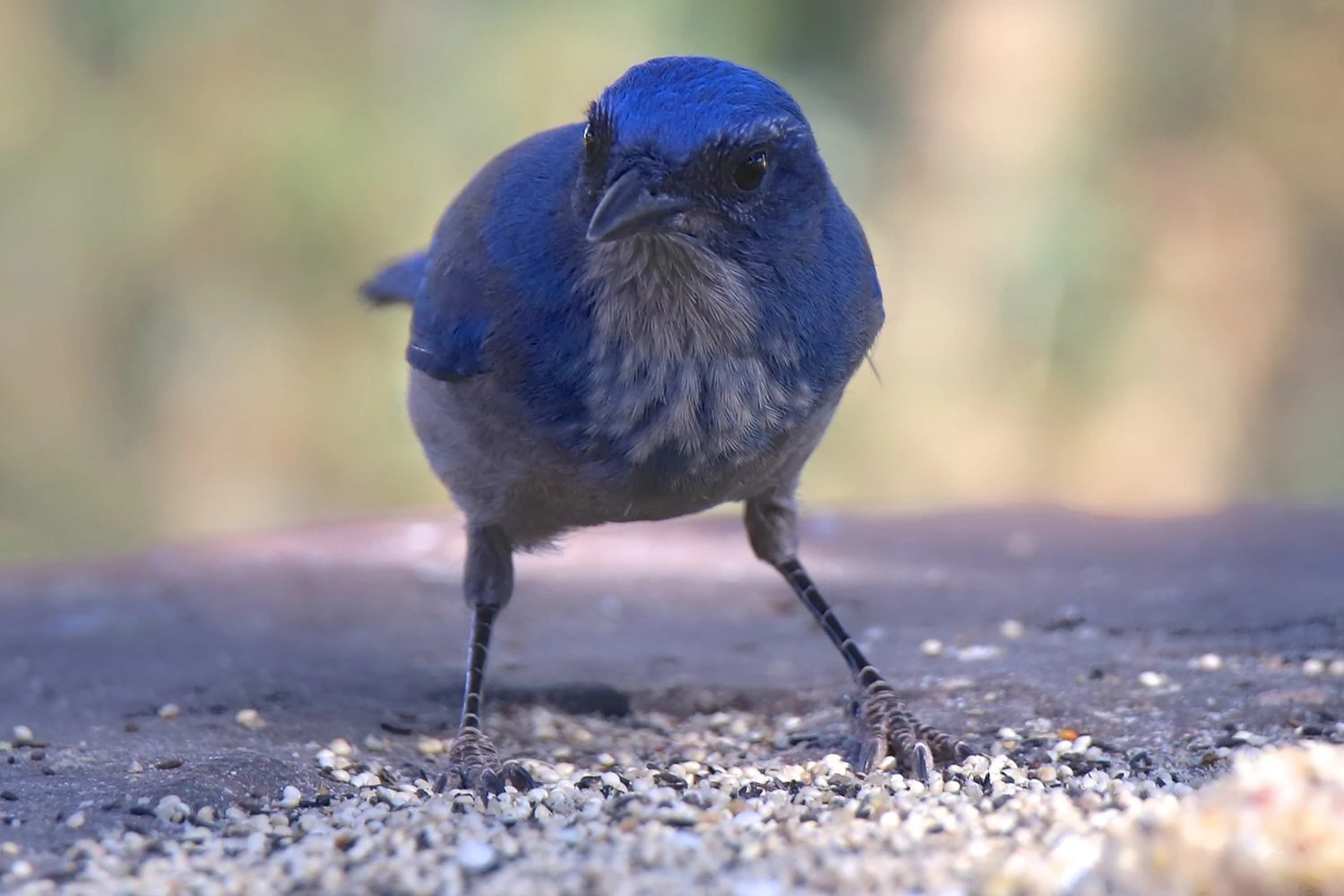
Woodhouse’s Scrub-Jays are the Blue-Jays of the Southwest with lovely blue and gray coloring. They are light blue and dark gray on the back and light gray underneath. Their tails are long and blue.
They are duller in color than California Scrub-Jays and have only a small necklace, and lack the crests of Blue Jays and Stellar’s Jays.
- Aphelocoma woodhouseii
- Length: 11.0-11.8 in (28-30 cm)
- Weight: 2.5-3.5 oz (70-100 g)
Woodhouse’s Scrub-Jays are resident inland in southwest US states and Mexico. You can find them in wooded areas with pinyon-juniper and scrubby areas.
Insects and fruit make up most of the diet of Woodhouse’s Scrub-Jays in summer and nuts and seeds in winter.
Woodhouse’s Scrub-Jay sounds:
Nests of Woodhouse’s Scrub-Jay are fairly simple platforms made of twigs and lined with moss and grass.
Attract Woodhouse’s Scrub-Jays to your backyard with sunflower seeds and peanuts.
Fun Fact: Woodhouse’s Scrub-Jays are thieves that steal food from other birds stores, especially Acorn Woodpeckers’ granary tree store of acorns.
26. Pinyon Jay
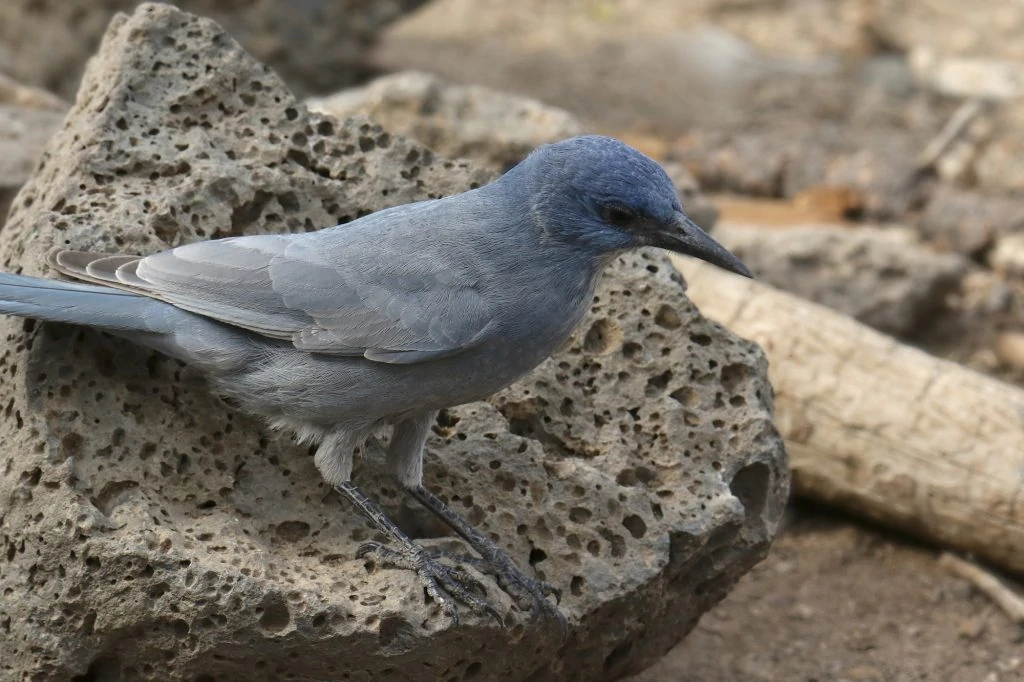
Pinyon Jays are blue all over, with darker backs and paler bellies. They also have white throats, shorter tails, and do not have crests like other Jays, like Stellar’s Jays. Males and females look the same, but juveniles can look more grayish-blue.
- Gymnorhinus cyanocephalus
- Length: 10.2-11.4 in (26-29 cm)
- Weight: 3.2-4.2 oz (90-120 g)
- Wingspan: 18.1 in (46 cm)
Pinyon Jays are resident inland in western US states in pinyon-pine forests.
As well as seeds from pinyon-pine, Pinyon Jays will eat juniper berries, acorns, and other animals such as lizards, baby birds, and insects. They are opportunity feeders who will take most things and forage in large, noisy groups.
Pinyon Jay sounds: They make 3 ‘kaw’ like calls close together that rise and then fall and sometimes shake or tremble.
Nests of Pinyon Jays are built of sticks and grass in pine trees and lined with feathers and animal hair.
Fun fact: Pinyon Jays do not have feathers over their nostrils to prevent the sticky pine pitch from making them dirty.
27. Steller’s Jay

Steller’s Jays are large songbirds with black triangular crests that stick up from their heads. The rest of their heads and onto their chests and back are black, with the rest of their bodies being blue.
- Cyanocitta stelleri
- Length: 11.8-13.4 in (30-34 cm)
- Weight: 3.5-4.9 oz (100-140 g)
- Wingspan: 17.3 in (44 cm)
Steller’s Jays are resident in western US states, western Canada, Mexico, and Central America.
You can find Steller’s Jays in evergreen forests in the mountains, and they will also be found around picnic tables, campgrounds, and backyard feeders.
Steller’s Jays eat most things they can forage for, including insects, seeds, nuts, berries, eggs, and nestlings, but also making a nuisance of themselves around garbage and your unguarded picnic!
Steller’s Jay sounds: They make ‘kaw’ sounds as well as fast two-toned calls, peeps, and harsh guttural sounds. Steller’s Jays can also mimic other noises such as other bird species and even sprinklers and alarms.
Nests of Stellar’s Jays are usually near the top of conifer trees and are built from leaves and plant material held together with mud and lined with soft pine needles.
Attract Steller’s Jays to your backyard with peanuts and suet.
Fun fact: Stellar’s Jays make nests out of the mud.
28. Great-tailed Grackle
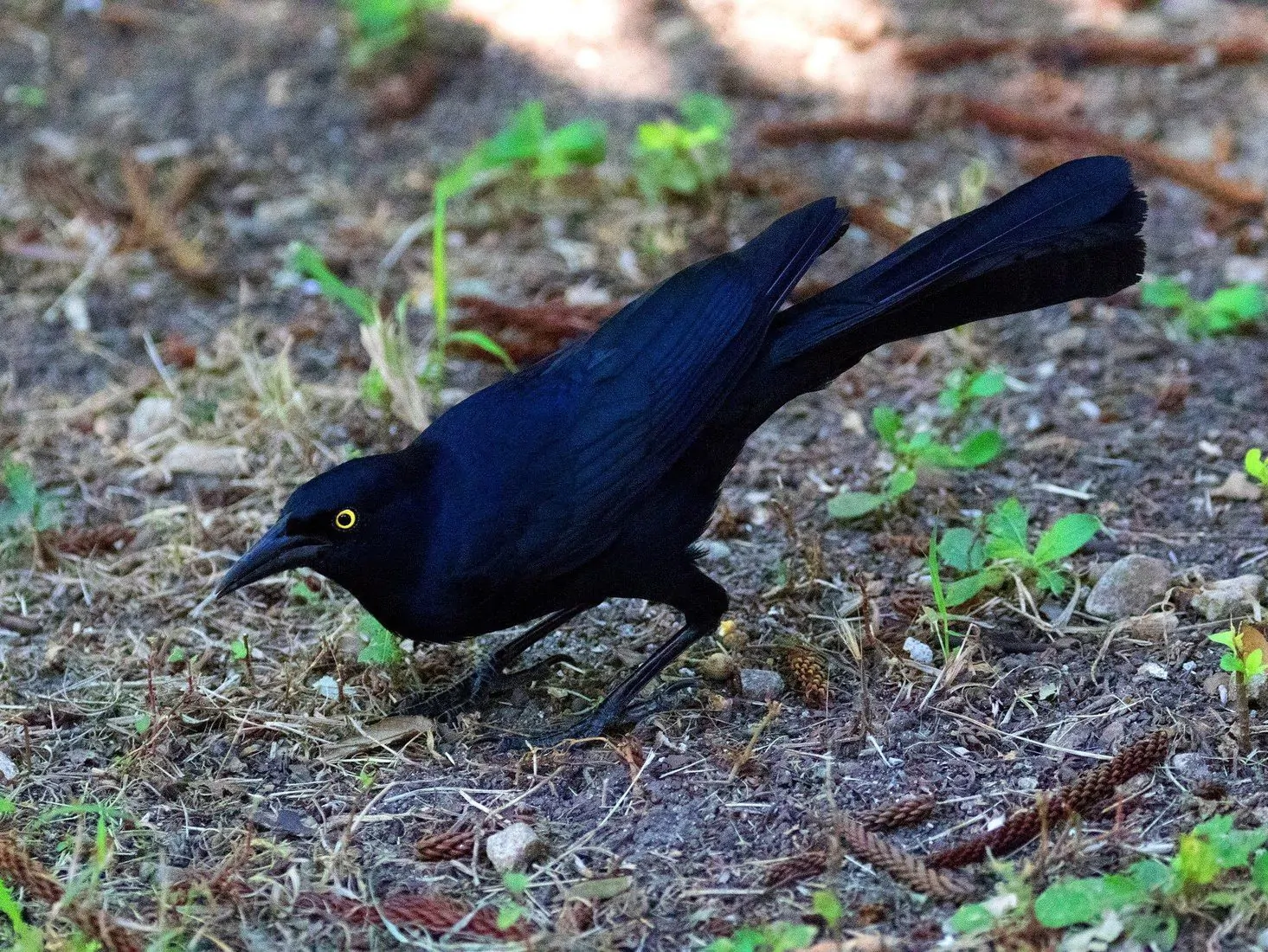
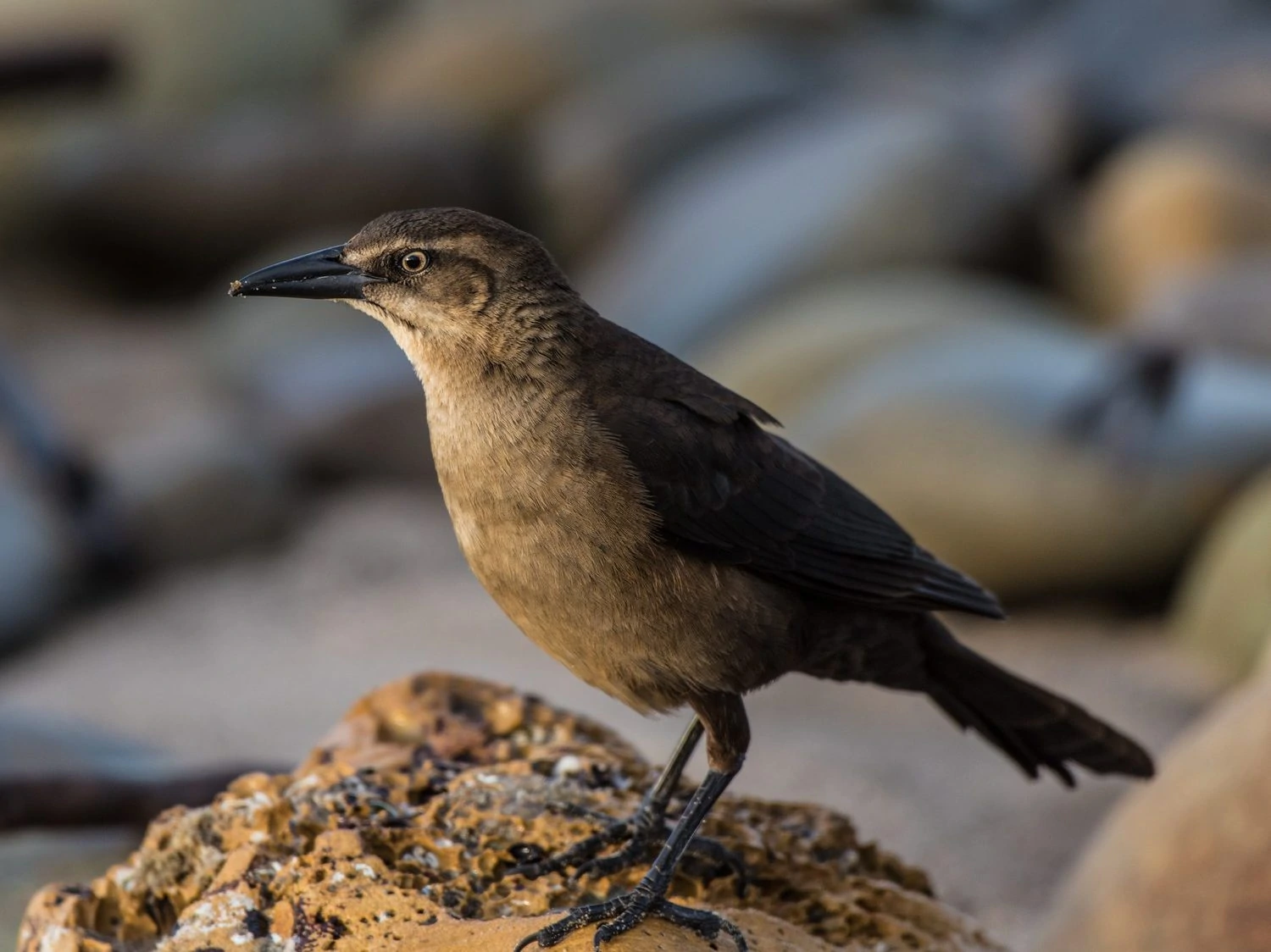
Great-tailed Grackles are long slender blackbirds with impressive long tapered tails in the males. Males are iridescent black with piercing yellow eyes. Females are also long-legged and slender but are dark brown on the back and lighter brown underneath, with more slender tails.
- Quiscalus mexicanus
- Length: 15.0-18.1 in (38-46 cm)
- Weight: 3.7-6.7 oz (105-190 g)
- Wingspan: 18.9-22.8 in (48-58 cm)
Great-tailed Grackles can be found in the West and Midwest in agricultural and urban areas, generally where humans are.
Great-tailed Grackles’ diet is grains, seeds, and fruit, as well as insects and other animals such as worms, beetles, spiders, bees, slugs, and snails. They will also sometimes eat small mammals and lizards as well as eggs and nestlings.
Great-tailed Grackle sounds: They have a fantastic array of whistles, shrieks, and rattles.
Nests of Great-tailed Grackles are usually high up in trees and made from grass, weeds, and twigs. First, mud lines the nest, followed by soft grass.
Great-tailed Grackles may be seen strutting across your lawn and can be attracted to seed dropping from feeders above. They will also eat black oil sunflower seeds, cracked corn, and millet on platform feeders or large hopper feeders.
Fun fact: Male Great-tailed Grackles are up to 60% heavier than females.
29. California Towhee
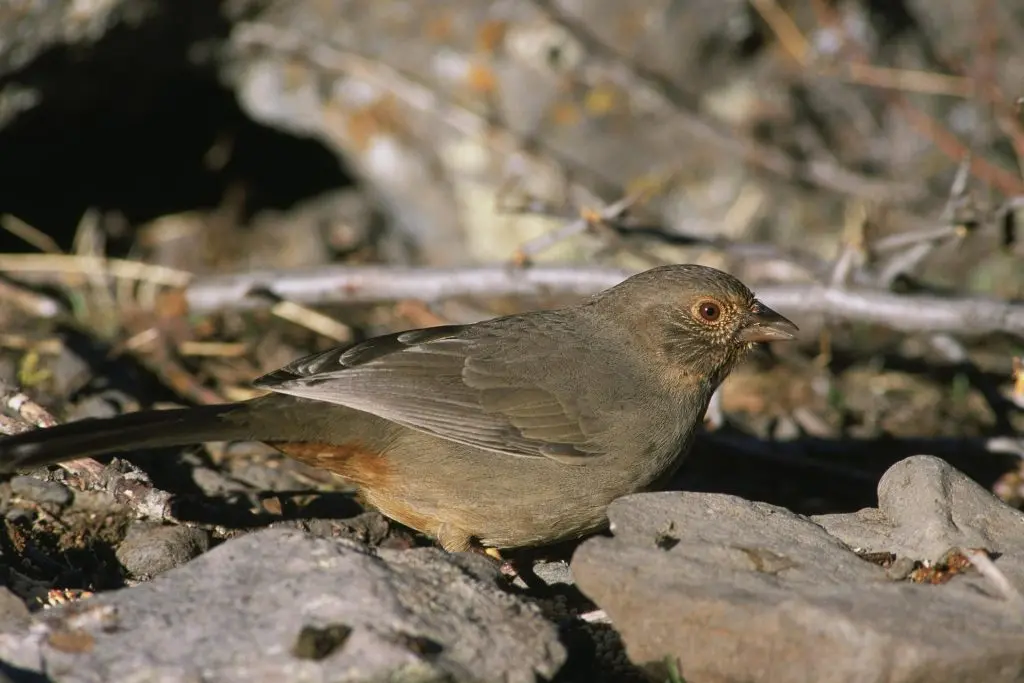
California Towhees are large, brown, plump sparrows with long tails, short wings, and a rusty patch under their tails.
- Melozone crissalis
- Length: 8.3-9.8 in (21-25 cm)
- Weight: 1.3-2.4 oz (37-67 g)
- Wingspan: 11.4 in (29 cm)
California Towhees are only found in the coastal chaparral scrub areas of California, Oregon, and Baja California. They will also visit backyards, sit on fenceposts, and chase their reflections in car mirrors or windows.
California Towhees’ diets are mostly seeds from grasses and herbs, but they also eat berries such as elderberry, coffeeberry, and acorns.
California Towhee sounds: The males sing a simple song that consists of a short, fast trill at a couple of different pitches.
Nests of California Towhees are pretty low down in shrubs or small trees and are made from twigs and grass woven together. The inside of the nest is lined with softer material, such as animal hair and soft fluffy seeds.
They lay up to five eggs, and these take up to two weeks to hatch and at least a week for the young to fledge.
Attract Califonia Towhees to your yard with millet on-ground feeders and plant native berry plants.
Fun fact: California Towhees will attack their reflections in mirrors and windows.
30. American Tree Sparrow
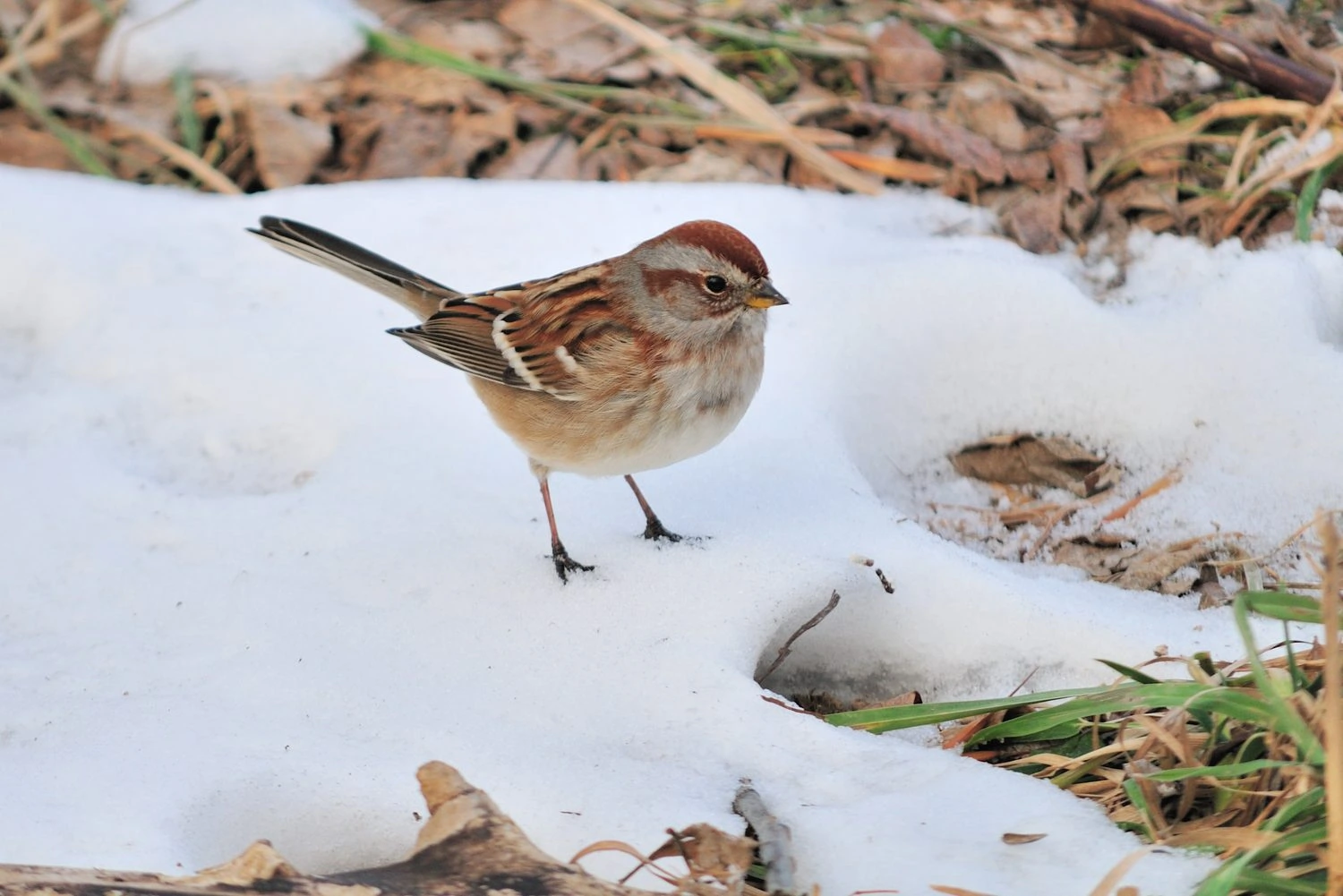
31. Black-billed Magpie

Black-billed Magpies, usually just called Magpies, are black and white birds that are noisy. They have long tails and blue-green iridescent flashes in the wing and tail. Males are up to 25% heavier than females.
- Pica hudsonia
- Length: 17.7-23.6 in (45-60 cm)
- Weight: 5.1-7.4 oz (145-210 g)
- Wingspan: 22.1-24.0 in (56-61 cm)
Black-billed Magpies live in northwestern US states and western Canada, and the coast of Alaska. They do not migrate.
You can find them walking on the ground in meadow and grasslands or other open areas feeding on fruit and grain, beetles, and grasshoppers. They have also been known to kill small mammals such as squirrels and voles and raid bird nests for eggs or nestlings and even carrion.
Black-billed Magpie sounds: A series of harsh calls and also a scream.
Nests of Black-billed Magpies are a messy ball-shaped collection of twigs with a neat cup of mud and soft material on the inside. They lay 6 – 7 eggs, and these take around three weeks to hatch and fledge a further 3 – 4 weeks.
You can attract Black-billed Magpies to your backyard with platform and suet feeders with black oil sunflower seeds, peanuts, fruit, suet, millet, and milo.
Fun Fact: A gathering of magpies calling around one of their dead is called a funeral.
32. Golden-crowned Sparrow
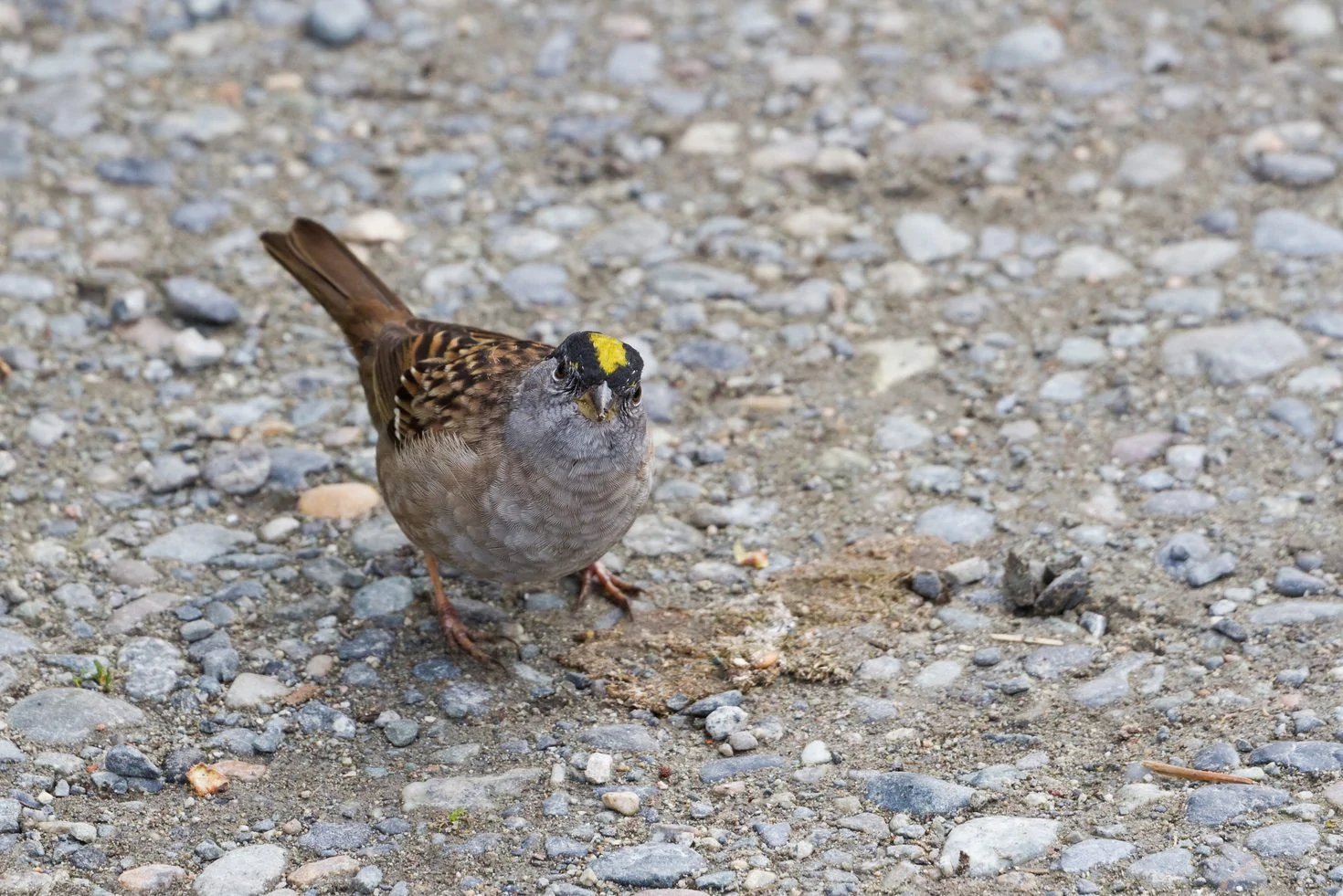
Golden-crowned Sparrows are grayish-brown underneath and streaked brown on the back. Their heads have a black crown and a bright-yellow forehead.
The colors are duller and brown on the crown in winter, and the yellow forehead is also duller.
- Zonotrichia atricapilla
- Length: 5.9-7.1 in (15-18 cm)
- Weight: 1.1-1.2 oz (30-33 g)
Golden-crowned Sparrows breed in Alaska and western Canada before migrating to the West Coast for winter.
You can find Golden-crowned Sparrow in weedy fields scratching for seeds such as dock, sumac, and geranium. They also eat fruit such as apples, grapes, elderberry, and olives. Insects also make up some of their diets, such as ants, beetles, butterflies, and termites.
Golden-crowned Sparrows sounds: Their song is a sad, slow series of whistles that decrease in pitch.
Nests of Golden-crowned Sparrows are usually on the ground and made from twigs, moss, and leaves. They are lined with softer material, such as animal hair, grass, and feathers.
They lay around four eggs, which take just under two weeks to hatch and a further ten days for the young to fledge.
Attract Golden-crowned Sparrows to your backyard with seeds on ground feeders or plant native plants that fruit.
Fun fact: The gold crown of Golden-crowned Sparrows shows how dominant they are, with larger crowns showing more dominance. This helps to reduce fights amongst males.
33. Fox Sparrow
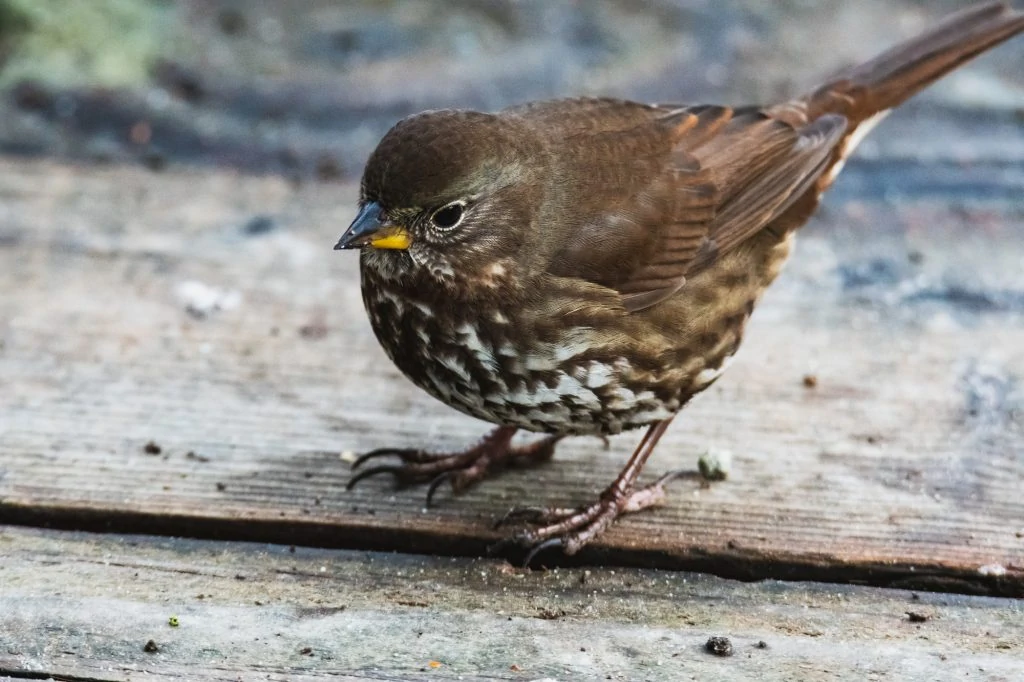
Although some species are more gray or dark brown, the Fox Sparrow is aptly named after its fox-red coloring. Its reddish streaks are particularly obvious in its chest area. It is a chunky bird compared to other sparrows.
There are four different color and appearance variations in Fox Sparrows. Red Fox Sparrows are found in eastern areas, and darker ‘sooty’ Fox Sparrows are found along the Pacific Coast. Thick-billed Fox Sparrows are found in California, and Slate-colored Fox Sparrows are found in western US states.
- Passerella iliaca
- Length: 5.9-7.5 in (15-19 cm)
- Weight: 0.9-1.6 oz (26-44 g)
- Wingspan: 10.5-11.4 in (26.7-29 cm)
Fox Sparrows migrate and breed in the north and west of Canada, Alaska, and down as far as California in the western US.
They spend the winter in southeastern US states and along the Pacific coast. Some remain all year on Canada’s Pacific coast, and they can be seen during migration in central and northeastern US states.
You can find Fox Sparrows in wooded areas, undergrowth, and brush. In the winter, they migrate to similar areas, even in well-vegetated suburbs and parks. You may observe them kicking up leaf litter in the air in search of food on the ground.
Insects and seeds are a common diet of Fox Sparrows. At times, they may also eat berries and grasses and crustaceans and marine animals if they’re near the beach.
Fox Sparrow sounds: Males sing a pleasant series of whistles and buzzy notes.
Nests of Fox Sparrow are hidden under dense, low shrubs. They may also build them in low trees but not more than eight feet above the ground. The nest is covered with grass, weeds, and moss but lined with dry grass. For those above ground, twigs are used to toughen up the nest’s walls.
They lay two to five eggs, which take about two weeks to hatch. The young may leave the nest within eleven days of hatching.
Attract Fox Sparrows to your backyard with small seeds and berries and low native shrubs.
Fun fact: The female Fox Sparrow can build a nest in a flash. They can start a nest at sunrise and finish it by dusk!
34. Woodhouse’s Scrub-Jay

Woodhouse’s Scrub-Jays are the Blue-Jays of the Southwest with lovely blue and gray coloring. They are light blue and dark gray on the back and light gray underneath. Their tails are long and blue.
They are duller in color than California Scrub-Jays and have only a small necklace, and lack the crests of Blue Jays and Stellar’s Jays.
- Aphelocoma woodhouseii
- Length: 11.0-11.8 in (28-30 cm)
- Weight: 2.5-3.5 oz (70-100 g)
Woodhouse’s Scrub-Jays are resident inland in southwest US states and Mexico. You can find them in wooded areas with pinyon-juniper and scrubby areas.
Insects and fruit make up most of the diet of Woodhouse’s Scrub-Jays in summer and nuts and seeds in winter.
Woodhouse’s Scrub-Jay sounds:
Nests of Woodhouse’s Scrub-Jay are fairly simple platforms made of twigs and lined with moss and grass.
Attract Woodhouse’s Scrub-Jays to your backyard with sunflower seeds and peanuts.
Fun Fact: Woodhouse’s Scrub-Jays are thieves that steal food from other birds stores, especially Acorn Woodpeckers’ granary tree store of acorns.
35. Canyon Towhee
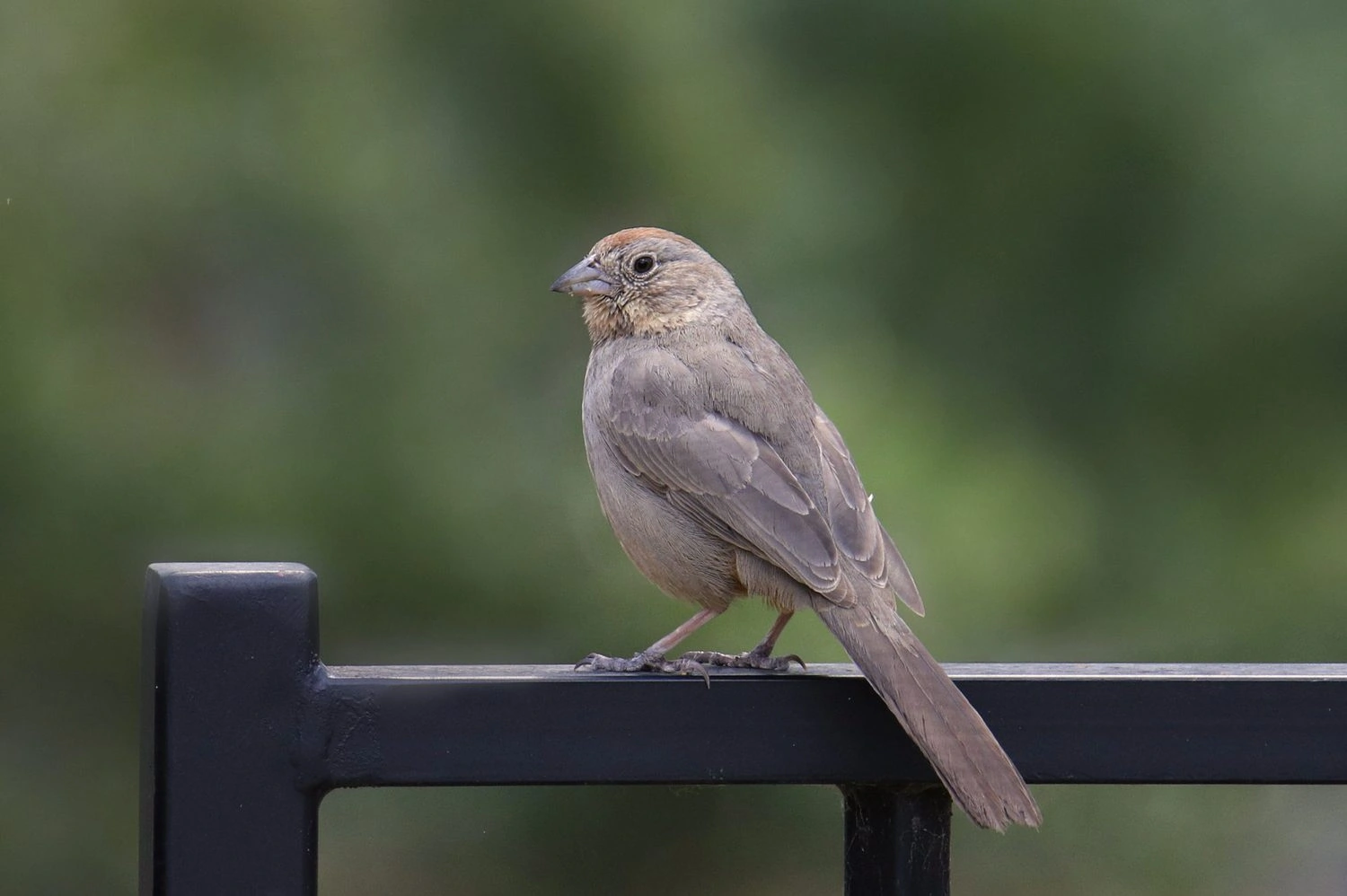
Canyon Towhees are plain grayish-brown sparrows with long tails and plump bodies. Although they look similar to California Towhees, their range does not overlap.
- Melozone fusca
- Length: 8.3-9.8 in (21-25 cm)
- Weight: 1.3-1.9 oz (37-53 g)
- Wingspan: 11.5 in (29.21 cm)
Canyon Towhees are resident all year in southwestern US states and Mexico.
You can find Canyon Towhees on the ground in desert grassland foraging mainly for seeds and berries. However, they will also eat some grasshoppers and other insects.
Canyon Towhee sounds: Their song is fast, stuttering, and two-toned.
Nests of Canyon Towhees are placed near the trunk of trees and large shrubs, so they are well supported and hidden. The nest is made by the female from grass and plant material and is lined with soft grass and animal hair.
Attract Canyon Towhees to your backyard with black oil sunflower seeds, milo, millet, and oats scattered on the ground. However, they are shy birds that can be hard to attract.
Fun fact: Canyon Towhees will nest when the twice-yearly desert rains are due, which provides a sudden abundance of plants and insects.
36. Harris’s Sparrow
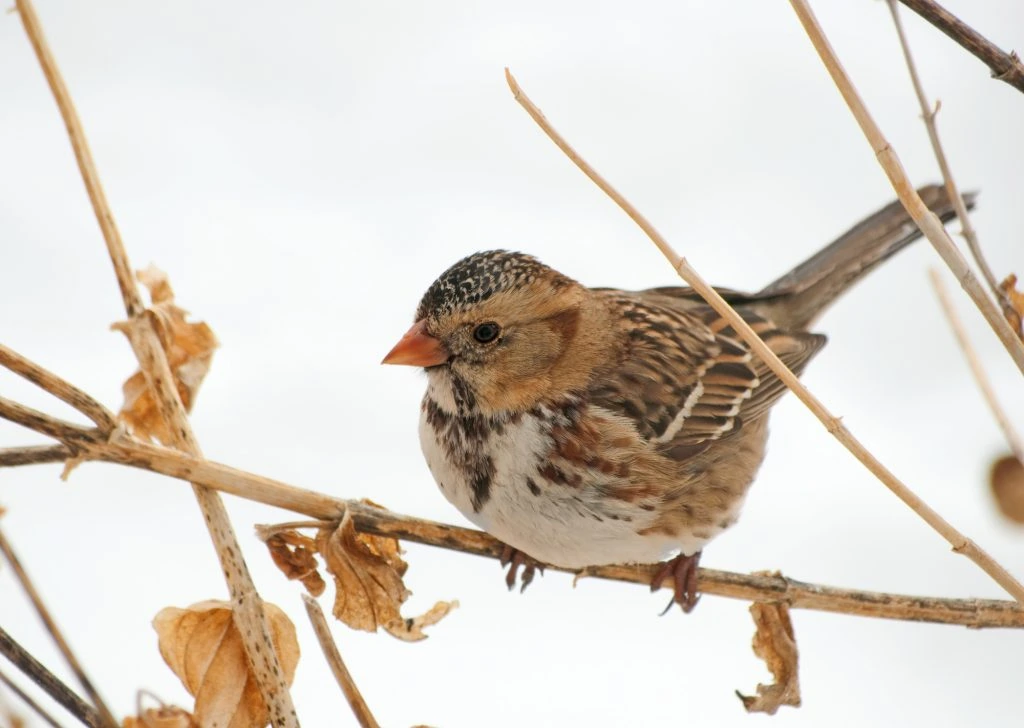
Harris’s Sparrows are distinctive, with a black face and bib darker in adults than juveniles. They also have brown-streaked bodies, with pale bellies and pink bills. Breeding adults have gray heads, but non-breeding adults have brown heads.
- Zonotrichia querula
- Length: 6.7-7.9 in (17-20 cm)
- Weight: 0.9-1.7 oz (26-49 g)
- Wingspan: 10.6 in (27 cm)
Harris’s Sparrows breed in the northern tundra of central Canada and migrate to south-central Great Plains for winter. They can be seen during migration across central US states and Canadian provinces.
You can find Harris’s Sparrows out in the open during their migration or in winter in fields or other open areas. They eat seeds, fruit, insects, and especially crowberries in spring when nesting, and there is less food around.
Harris’s Sparrow Call/Song:
Nests of Harris’s Sparrows are on the ground and made from twigs and moss and lined with soft grass. They lay up to five eggs which take around two weeks to hatch and a further nine days or so for the young to leave the nest.
Attract Harris’s Sparrows to your backyard in winter with black oil sunflower seeds, millet, and cracked corn.
Fun fact: Harris’s Sparrows are the only songbird that breeds in Canada and nowhere else.
37. Pyrrhuloxia
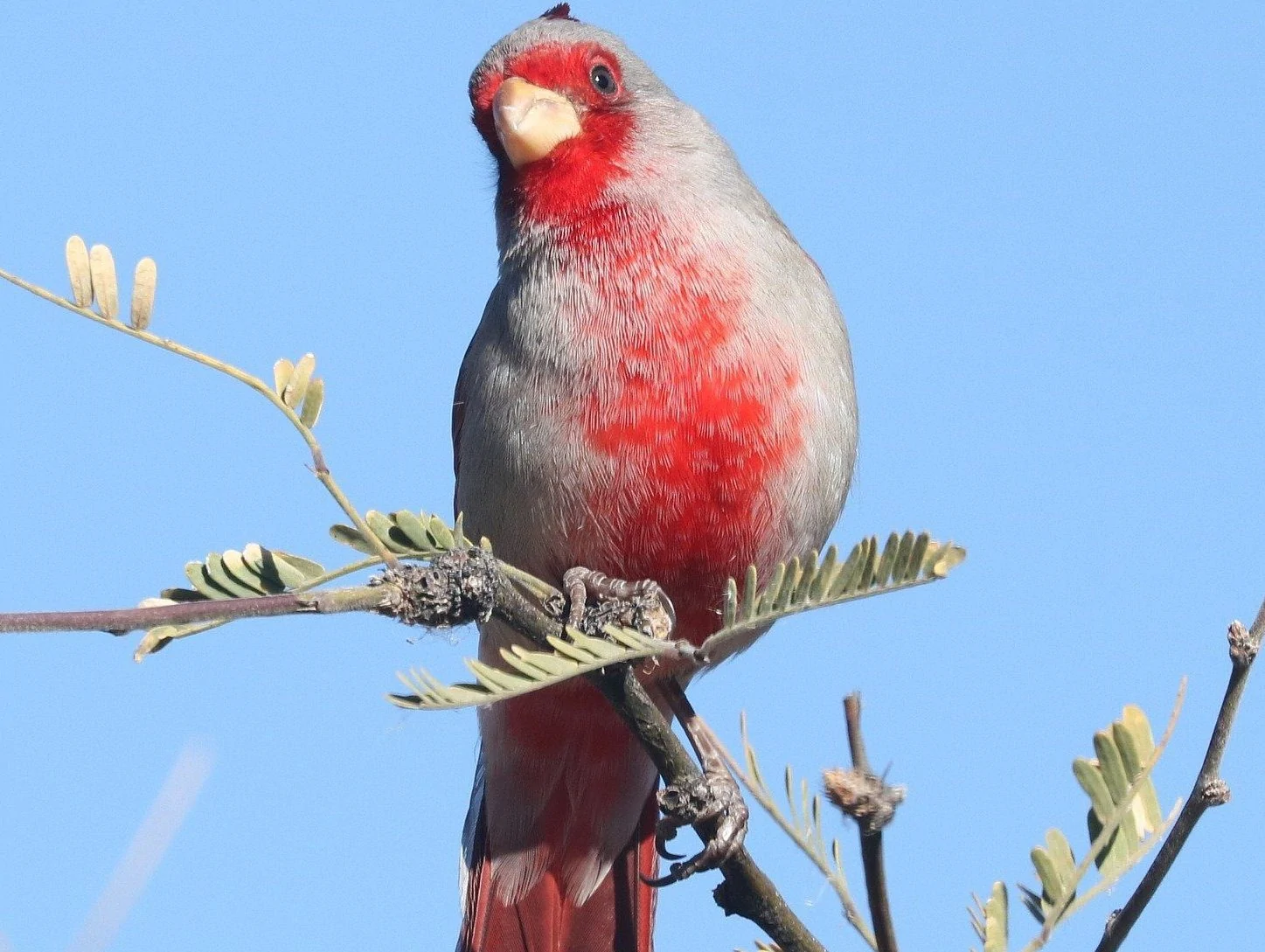
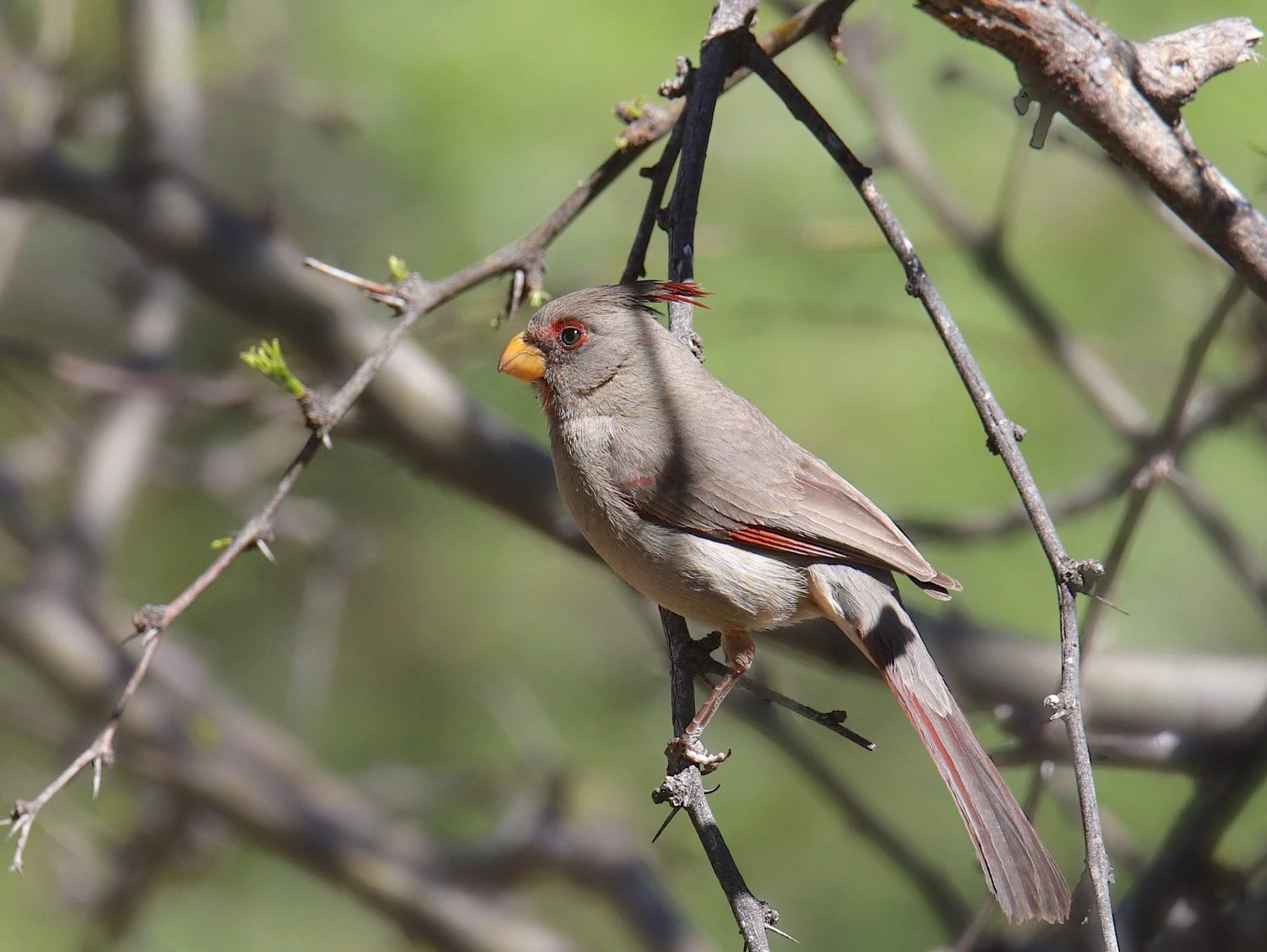
Pyrrhuloxia males are grey with lots of red coloring to the face, crest, breast, and tail. Females are dull gray with less red coloring.
- Cardinalis sinuatus
- Length: 8.3 in (21 cm)
- Weight: 0.8-1.5 oz (24-43 g)
They are residents of the hot deserts in Texas, New Mexico, Arizona, and Mexico.
During the breeding season, they fiercely defend their territory, but in winter, they can be found in flocks of up to 1000.
Pyrrhuloxia feed mostly on seeds but also insects. They can be found at feeders with sunflower seeds but more often prefer them scattered on the ground.
Pyrrhuloxia Song:
Nests of Pyrrhuloxias are built by females from twigs, bark, and grass and line them with softer material, such as hair, plant material, and feathers. The nests are in trees or shrubs at the end of branches. They lay around three eggs, which take two weeks to hatch and around a further twelve days for the young to leave the nest.
Attract Pyrrhuloxias to your backyard with sunflower seeds and native fruiting shrubs.
Fun fact: Pyrrhuloxias rarely drink water, which is good as it is so scarce in their desert habitat. Instead, they get moisture from eating their insect prey.
38. Western Meadowlark
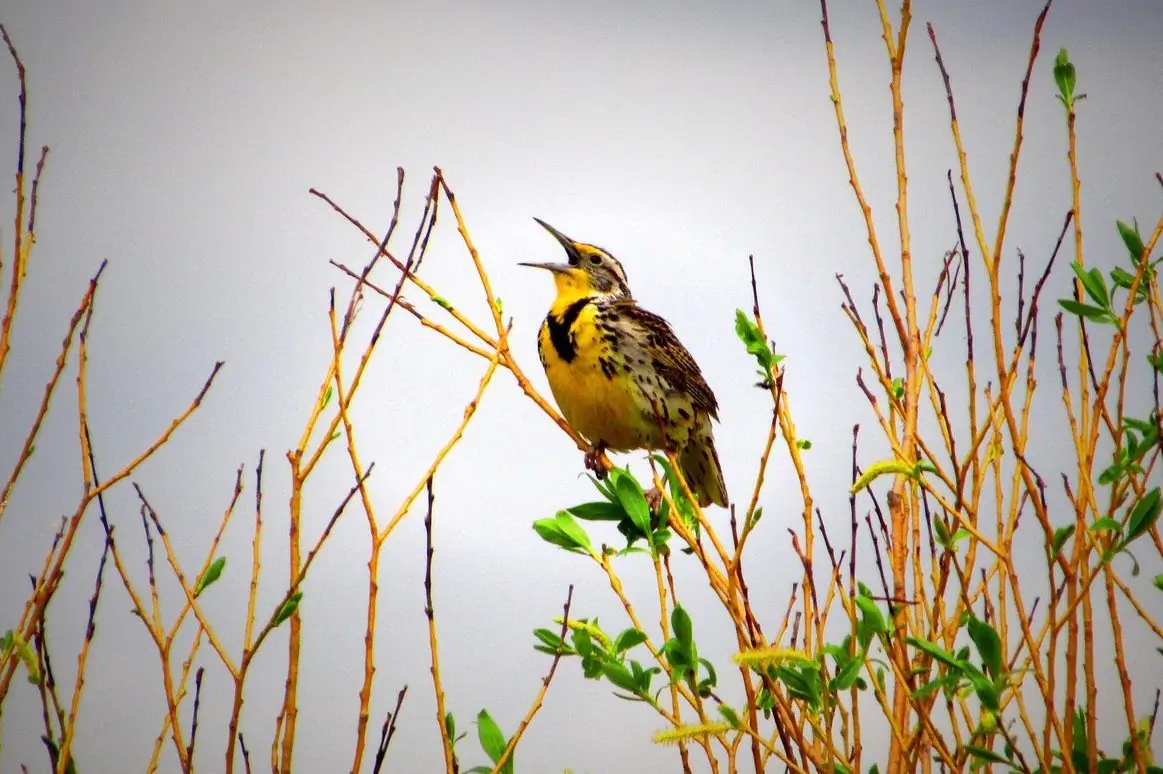
With their bright yellow bellies and melodious song, Western Meadowlarks can brighten up your day. This is probably what makes them so popular, so popular in fact that they are the state bird of 6 US states.
Western Meadowlarks are members of the blackbird family and are about the size of a Robin with shades of brown and white upperparts and a black V-shaped band across the bright yellow chest that turns gray in winter.
- Sturnella neglecta
- Length: 6.3-10.2 in (16-26 cm)
- Weight: 3.1-4.1 oz (89-115 g)
- Wingspan: 16.1 in (41 cm)
Western Meadowlarks breed in northern US states and Canada before moving to more southern states. Those in The West and Midwest remain all year.
You can find Western Meadowlarks foraging for insects and seeds from weeds. Also, they look for seeds on the ground alone or in small flocks in grasslands, meadows, and fields.
Western Meadowlark Song:
Attract Western Meadowlarks to your backyard with hulled sunflower seeds and cracked corn.
39. Eastern Meadowlark
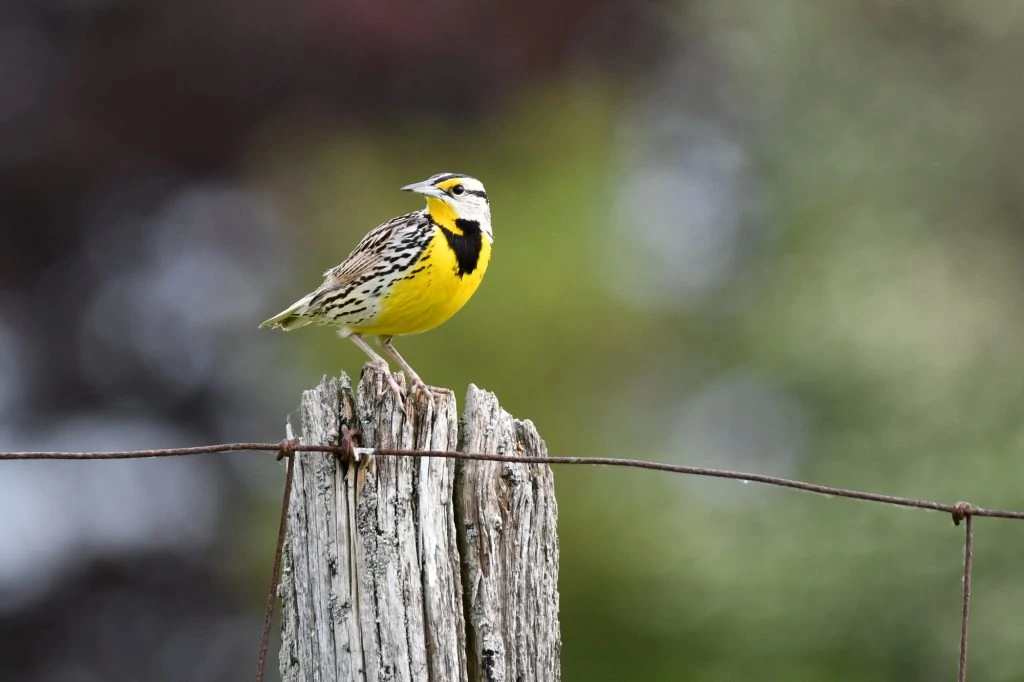
Eastern Meadowlarks are medium-sized songbirds that are bright yellow underneath and pale brown with black marks on the back. They have a distinctive black band across the chest.
- Sturnella magna
- Length: 7.5-10.2 in (19-26 cm)
- Weight: 3.2-5.3 oz (90-150 g)
- Wingspan: 13.8-15.8 in (35-40 cm)
Eastern Meadowlarks are found across eastern US states all year, but they will also breed in the Northeast and Canada before migrating south.
Spring in the East has arrived when the Eastern Meadowlark starts singing and putting on a display, but unfortunately, they are now classed as near-threatened.
They can be found on the ground in grasslands and prairies, eating insects. They gather in large flocks in fields in winter, looking for seeds.
Eastern Meadowlark sounds: They make flute-like whistles that are clear and melodious.
Nests of Eastern Meadowlarks are on the ground and can be pretty amazing constructions and include tunnels and roofs made of woven grasses.
40. Chipping Sparrow
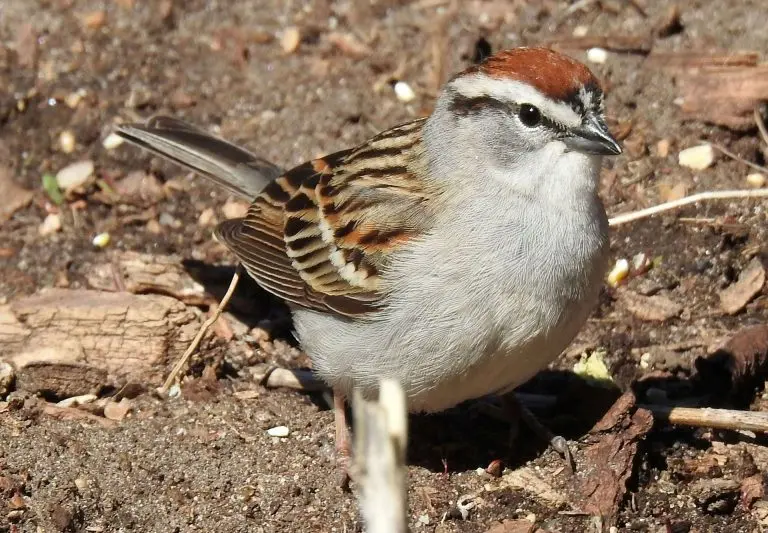
Chipping Sparrows are slender, long-tailed birds with a grayish belly and brown and black-streaked back, with a rusty crown and black eye line. In winter, the colors are more subdued.
- Spizella passerina
- Length: 4.7-5.9 in (12-15 cm)
- Weight: 0.4-0.6 oz (11-16 g)
- Wingspan: 8.3 in (21 cm)
Chipping Sparrows spend their summer breeding in the US and Canada before flying to Mexico and Florida for winter. Some remain all year in the southern states.
You can find Chipping Sparrows in small flocks on open ground and will come to backyards for many kinds of birdseed.
Chipping Sparrow Song:
Attract Chipping Sparrows to your backyard with seeds or cracked corn on open feeders such as hoppers or platforms.

